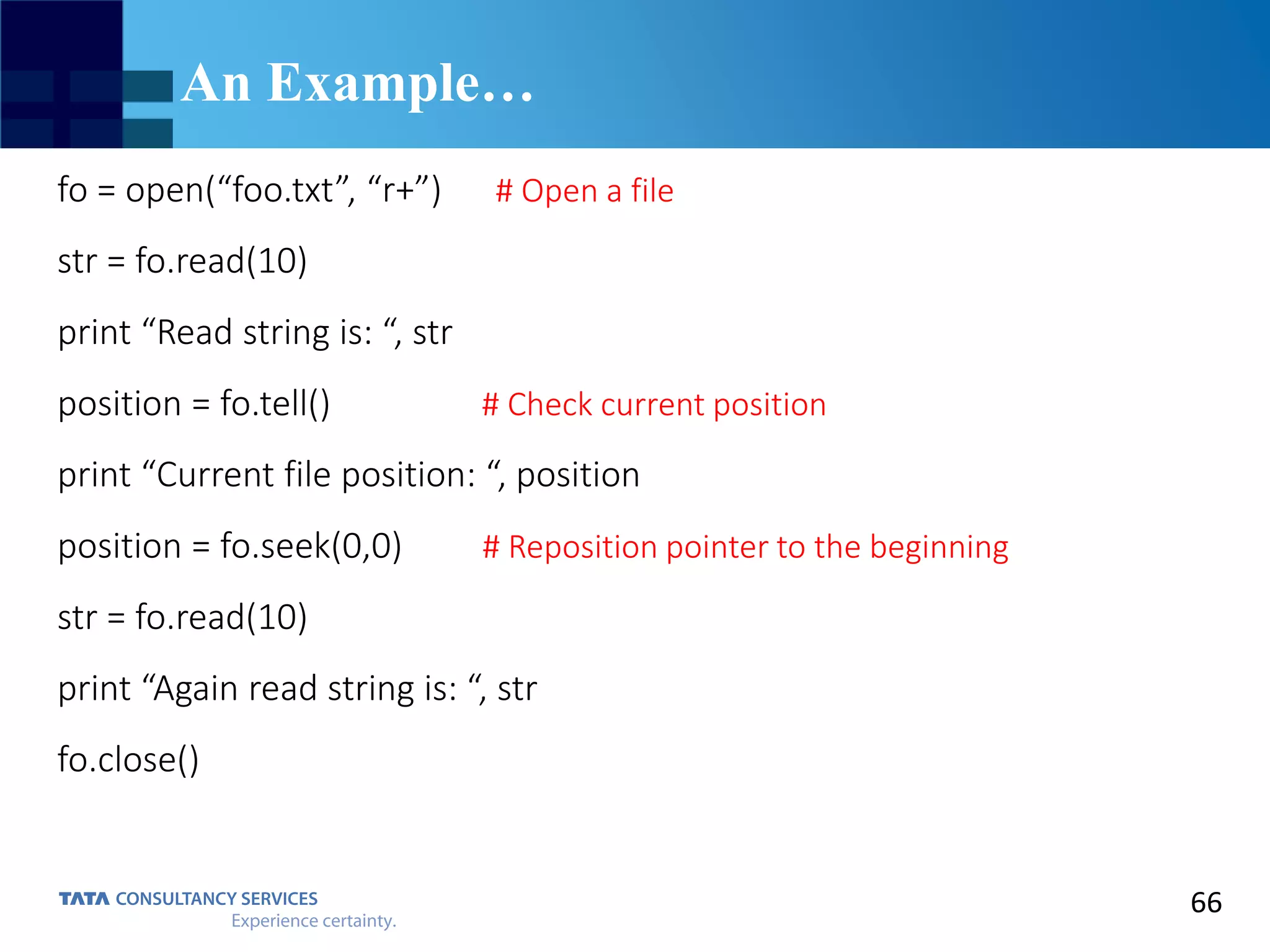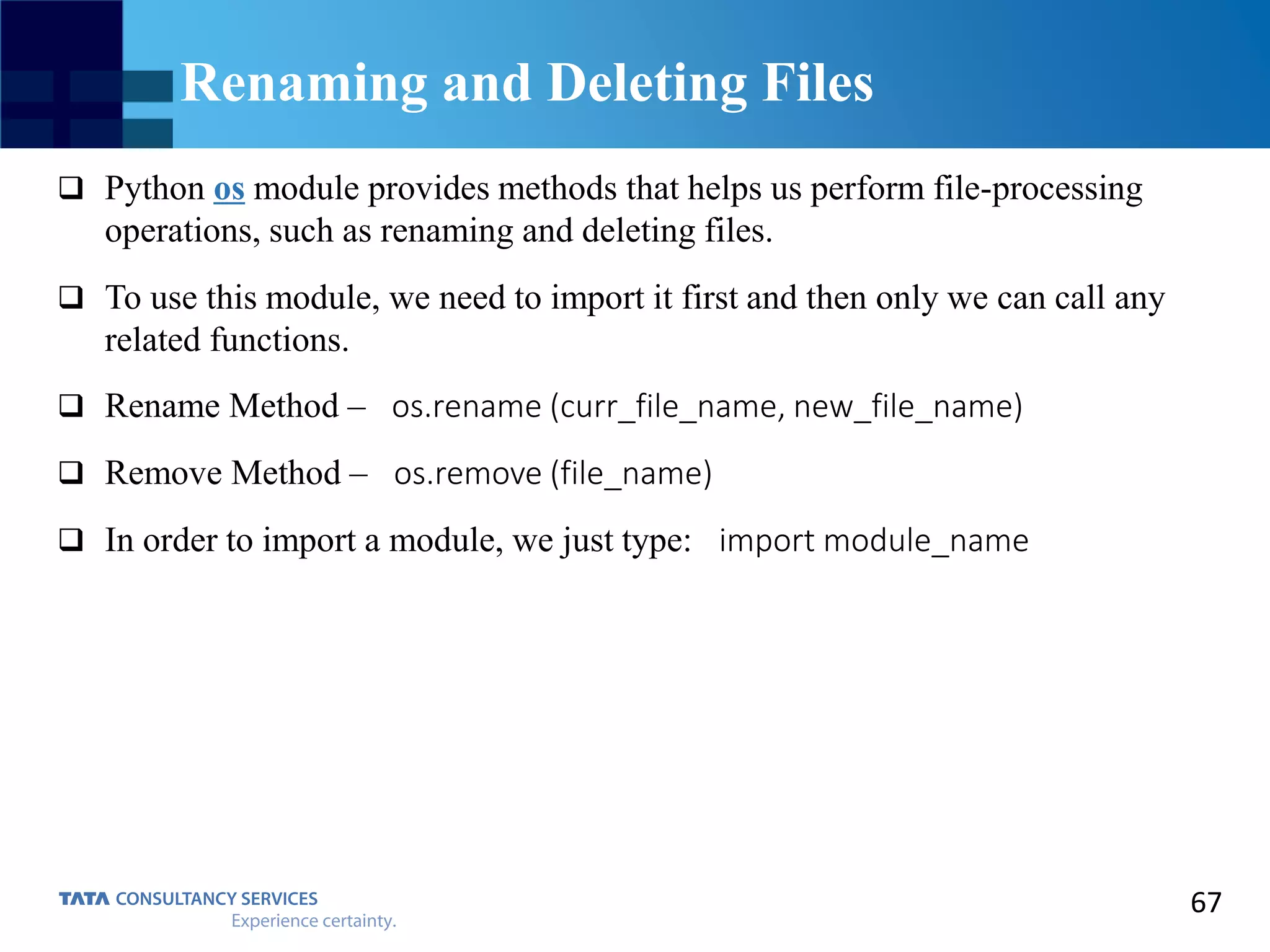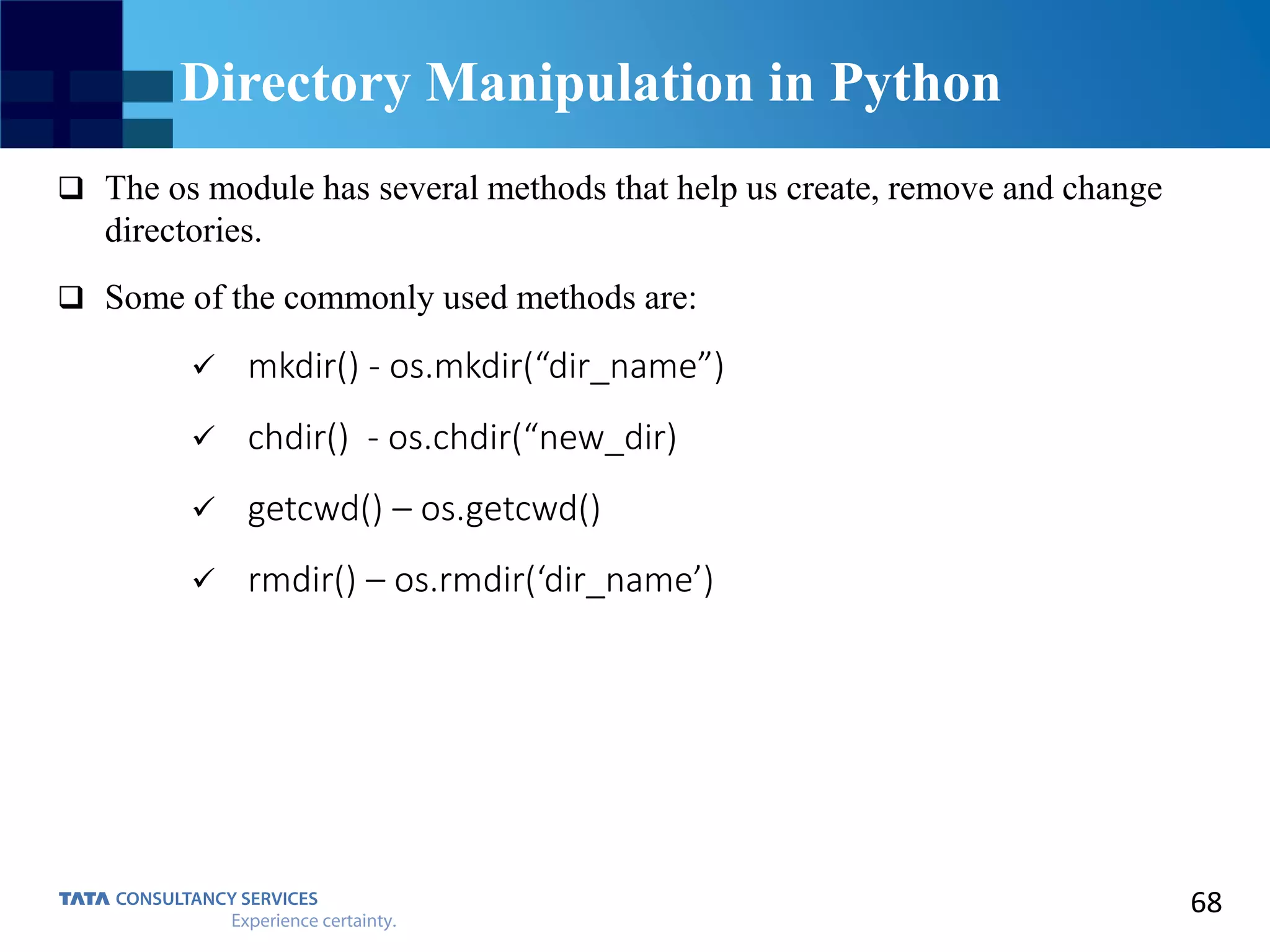The document provides an extensive overview of Python programming, covering its basic concepts, syntax, decision-making structures, loops, and data types. It emphasizes Python's clear syntax, dynamic typing, and object-oriented features, along with practical examples of its application. Important topics include variable assignment, control flow, sequence types (lists, tuples, strings), and mutability.
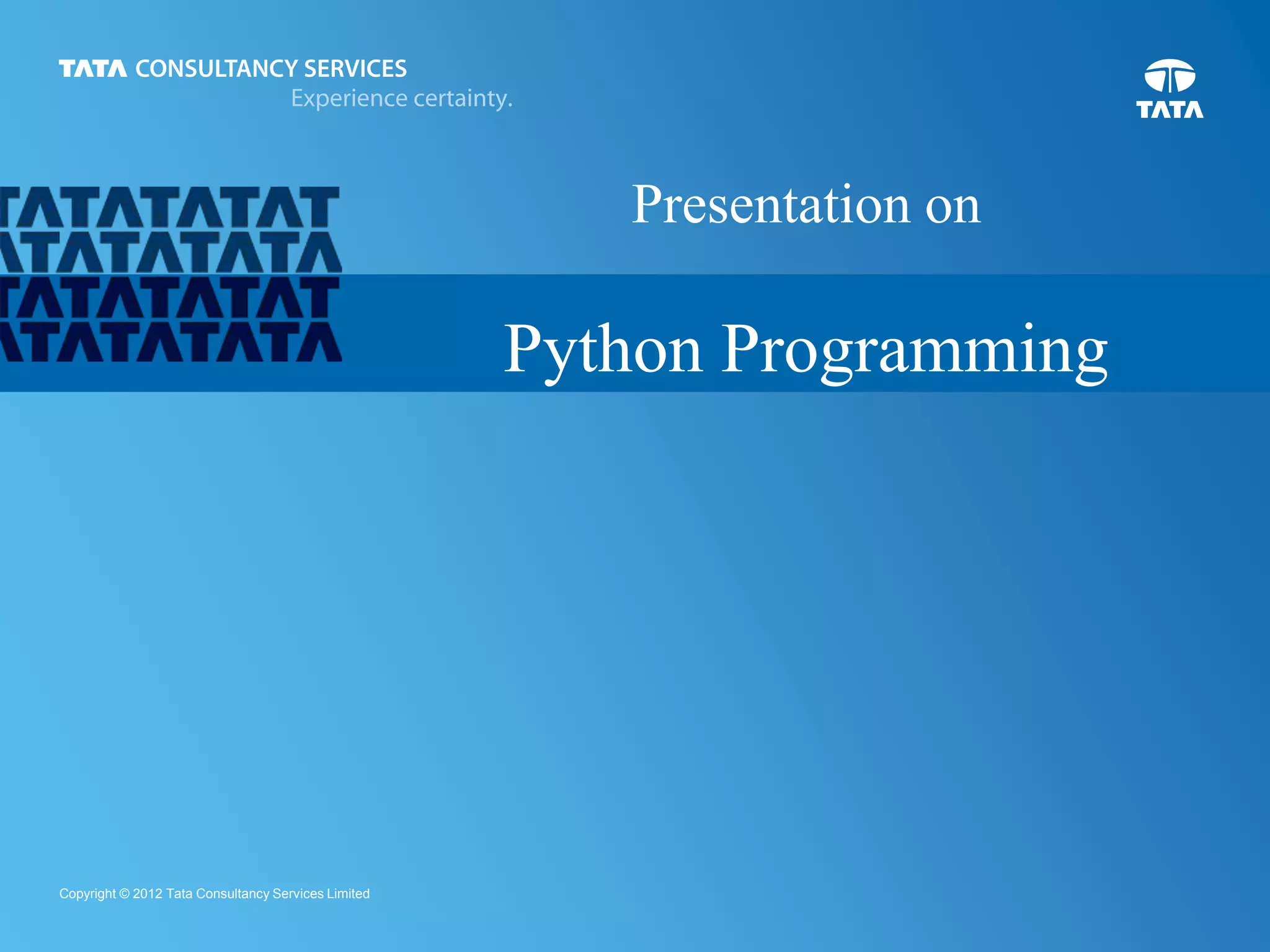
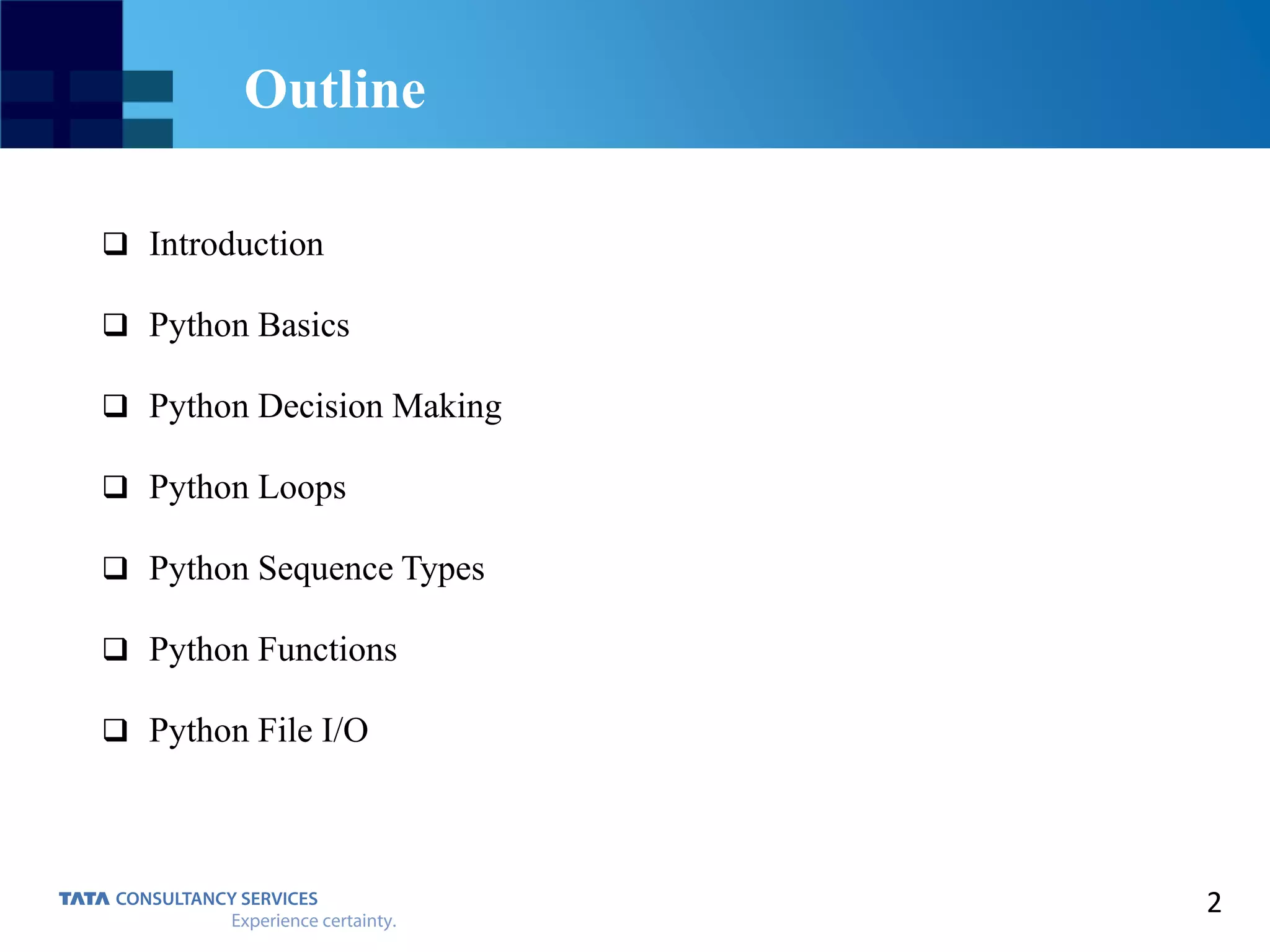
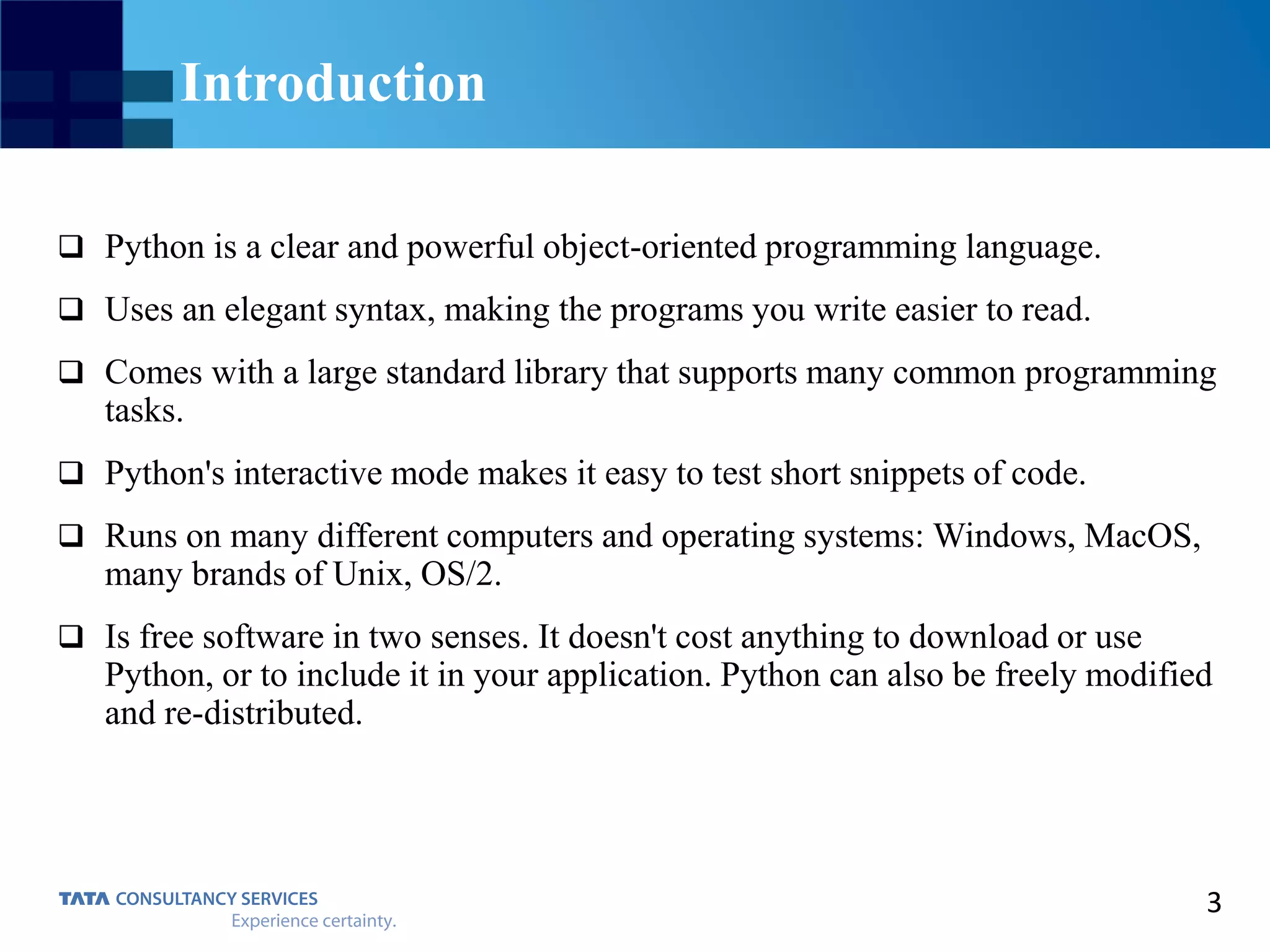
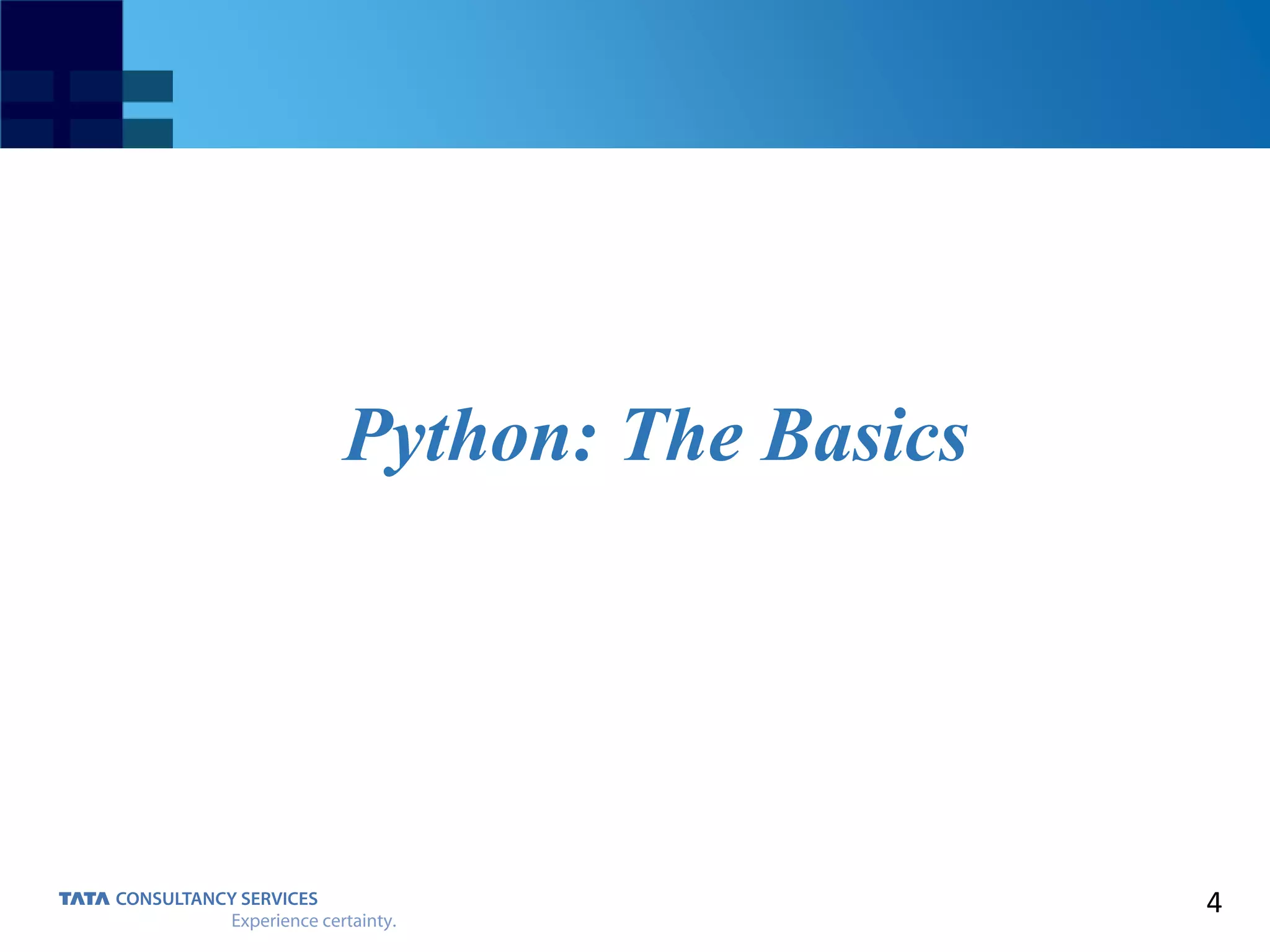
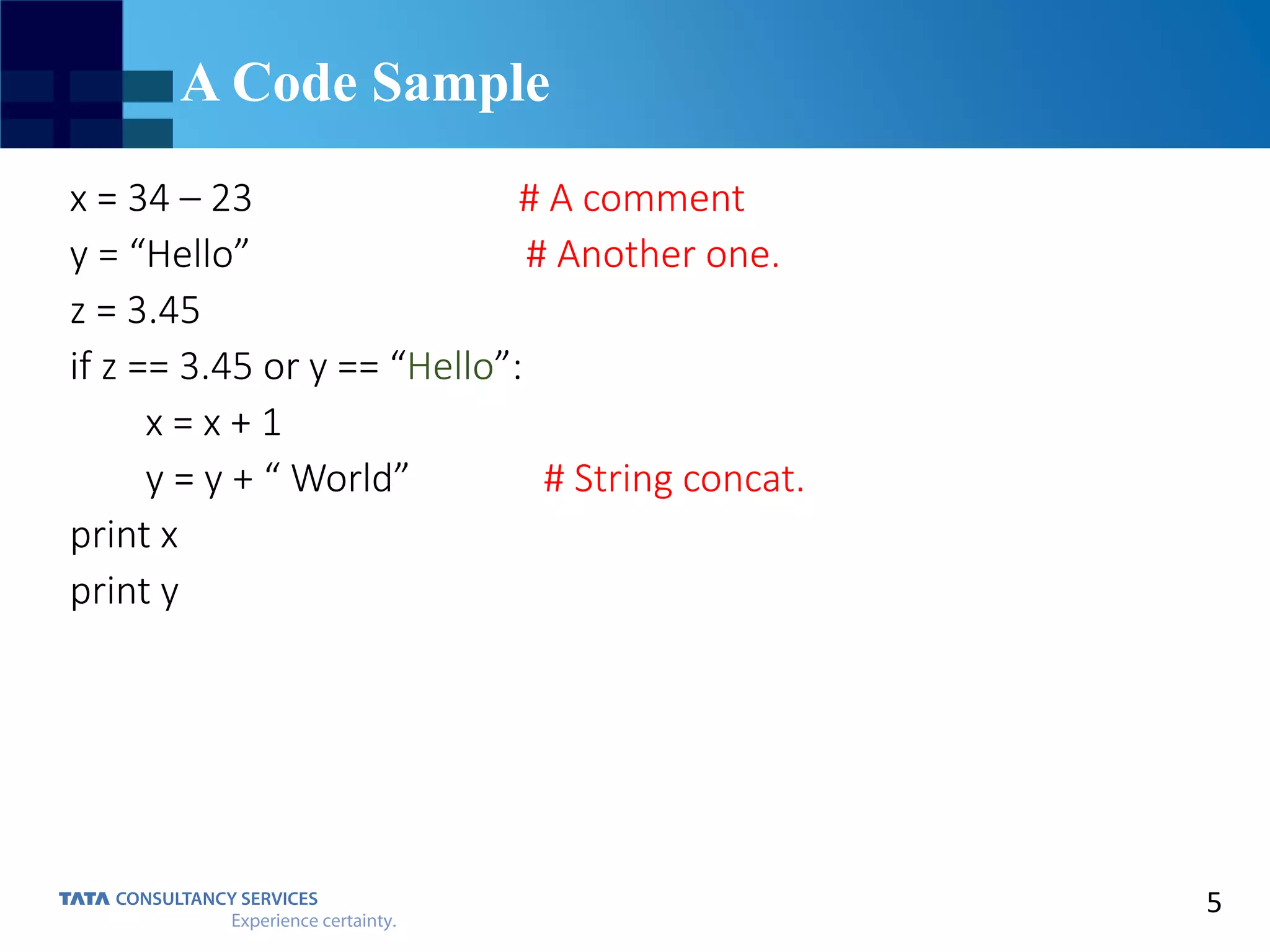
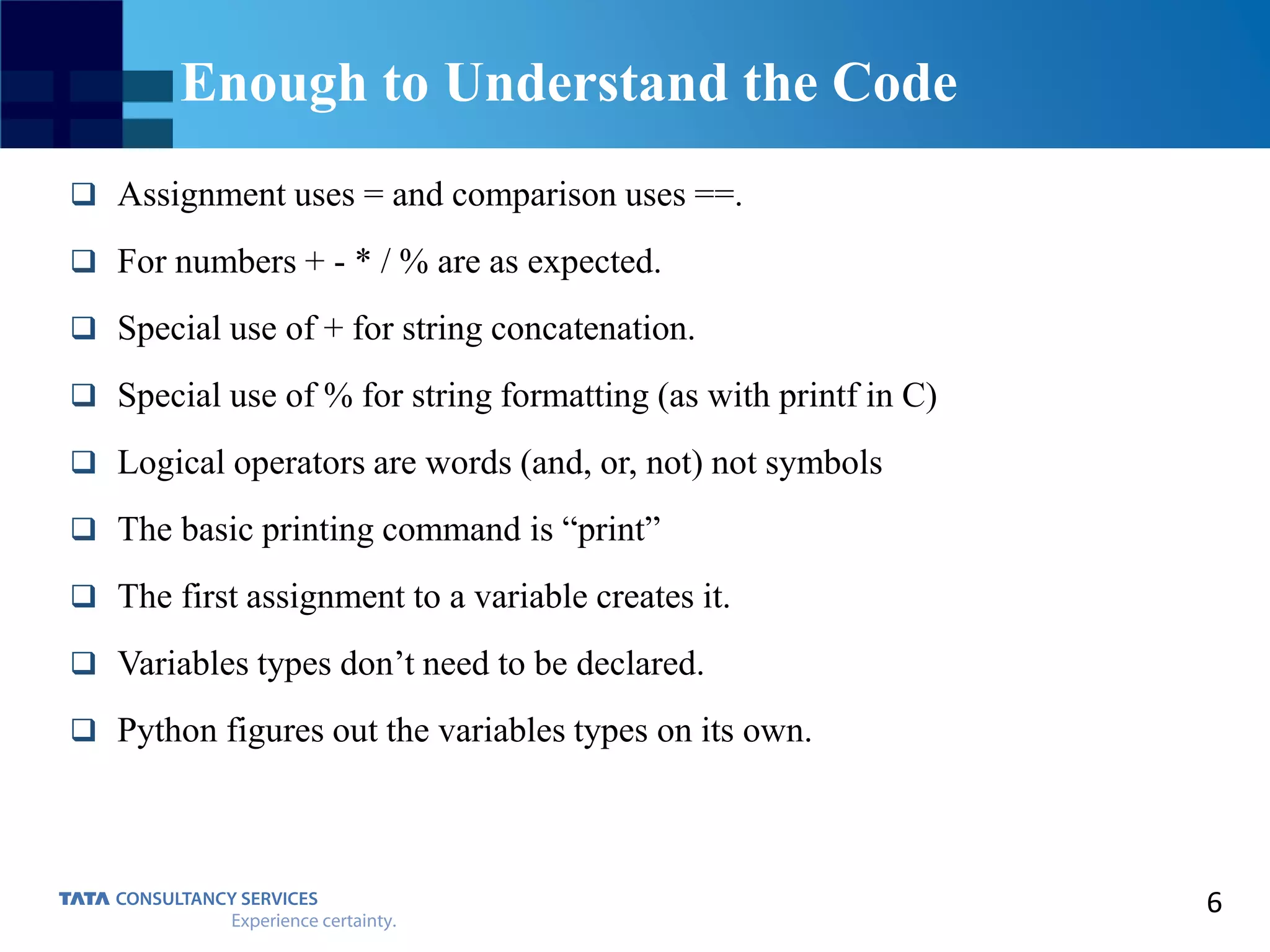
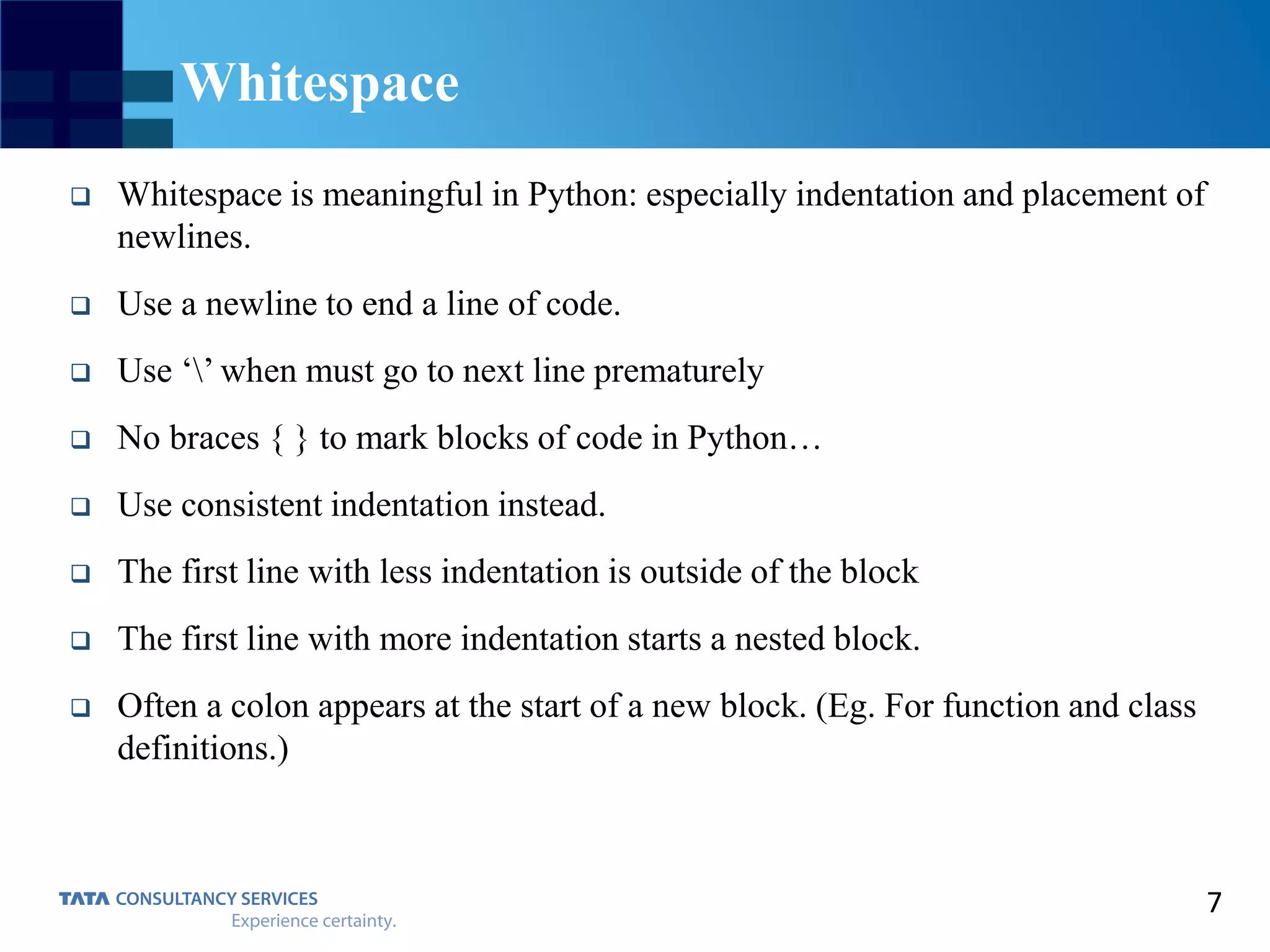
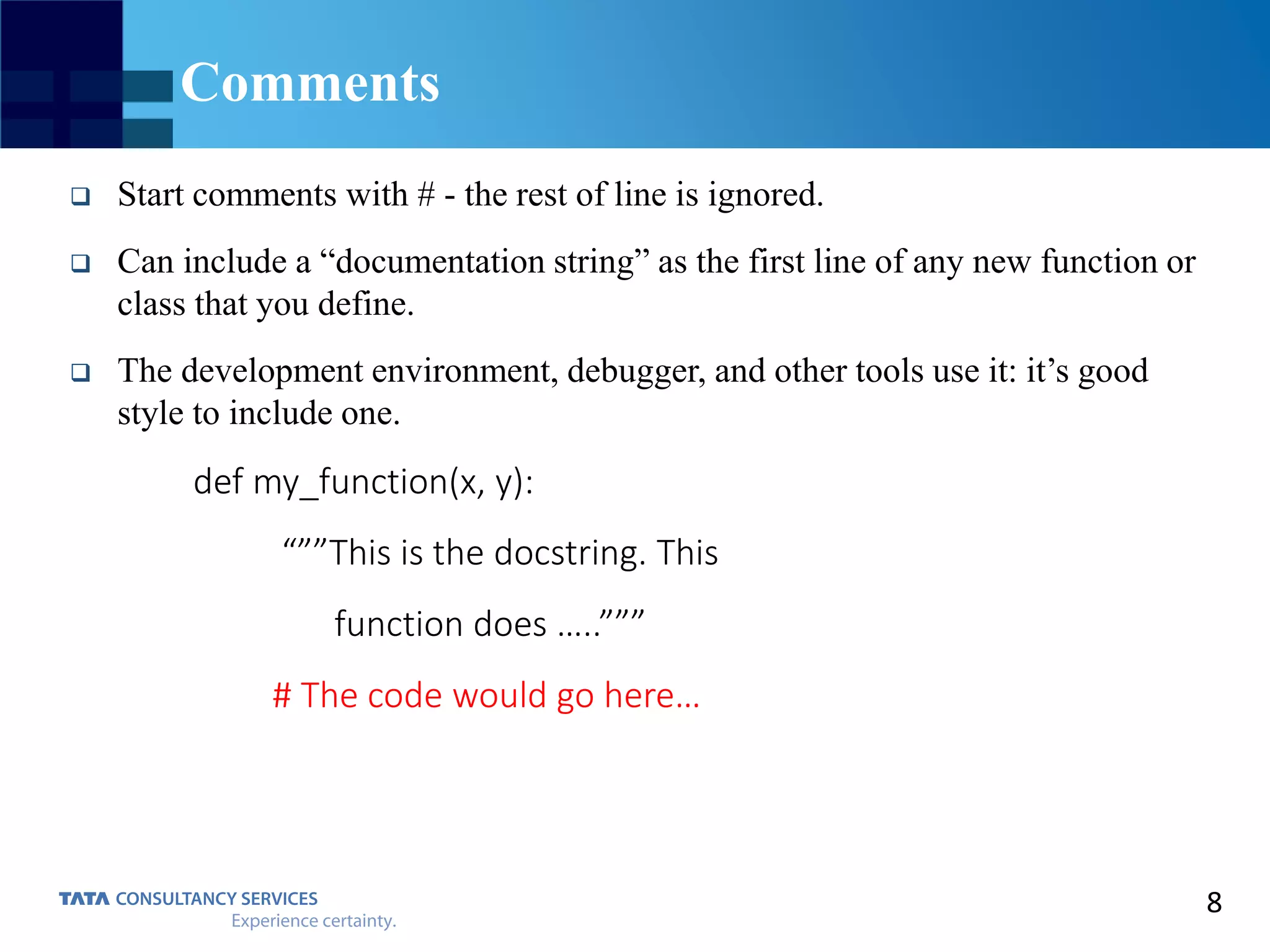
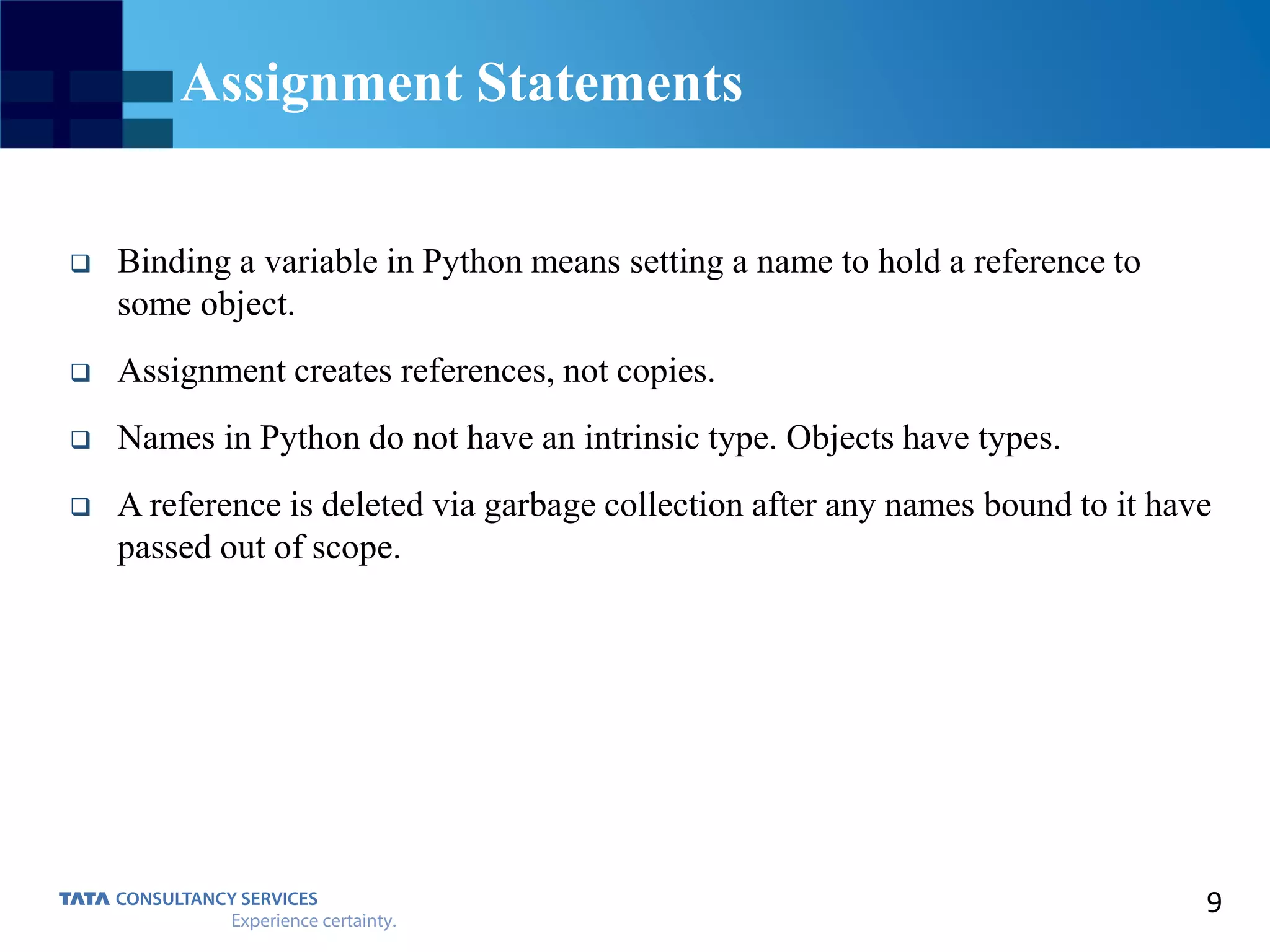
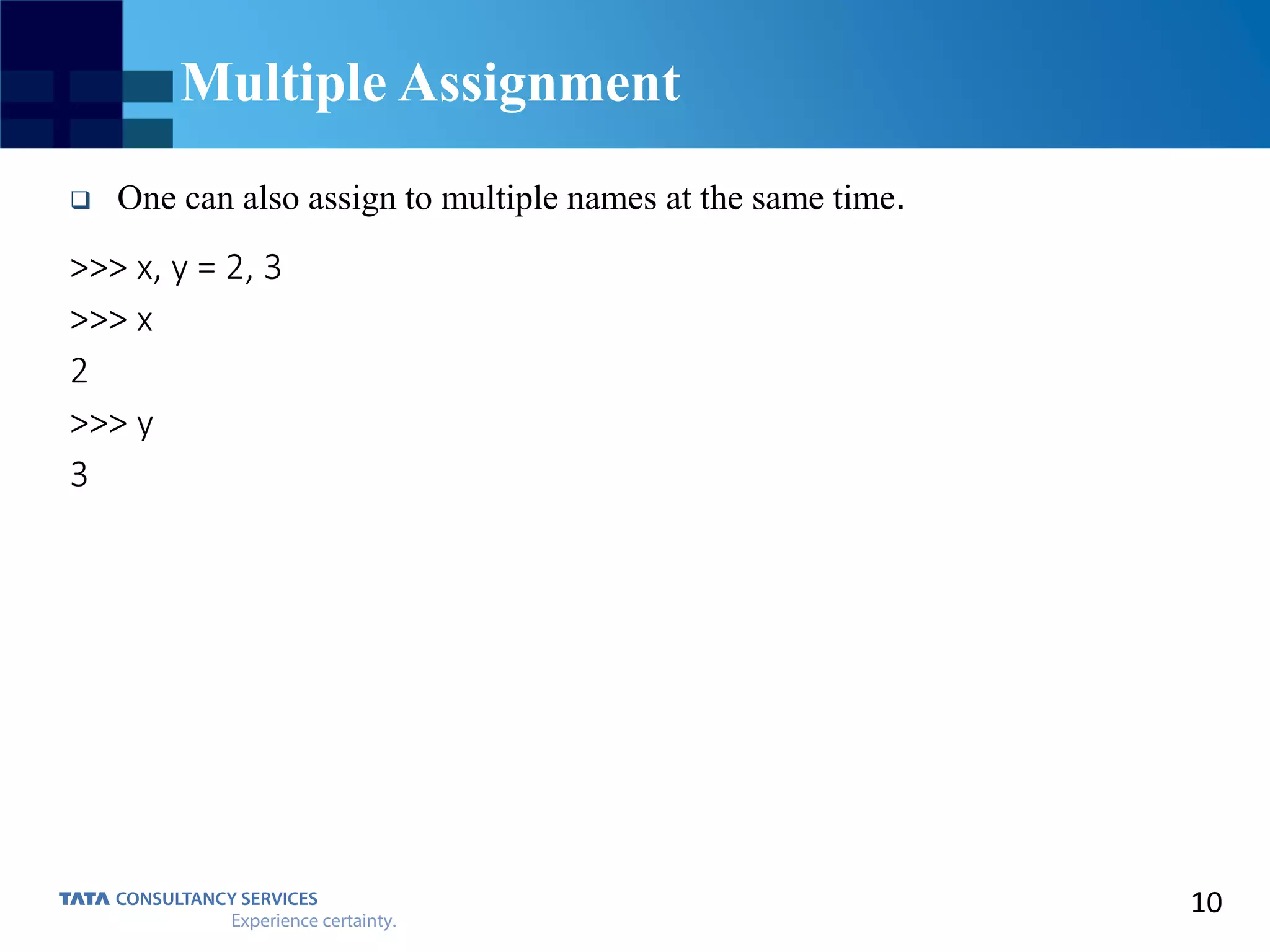
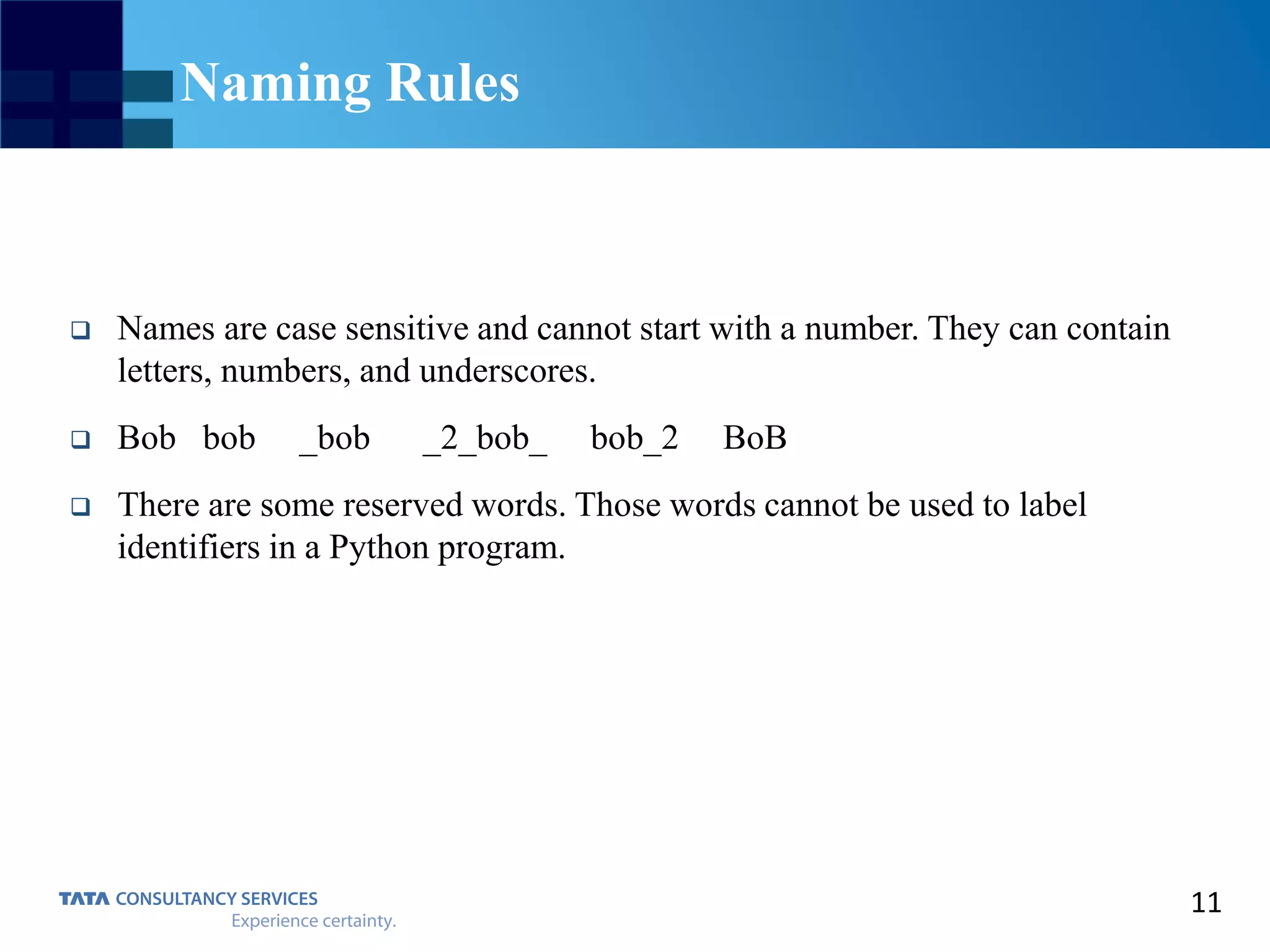
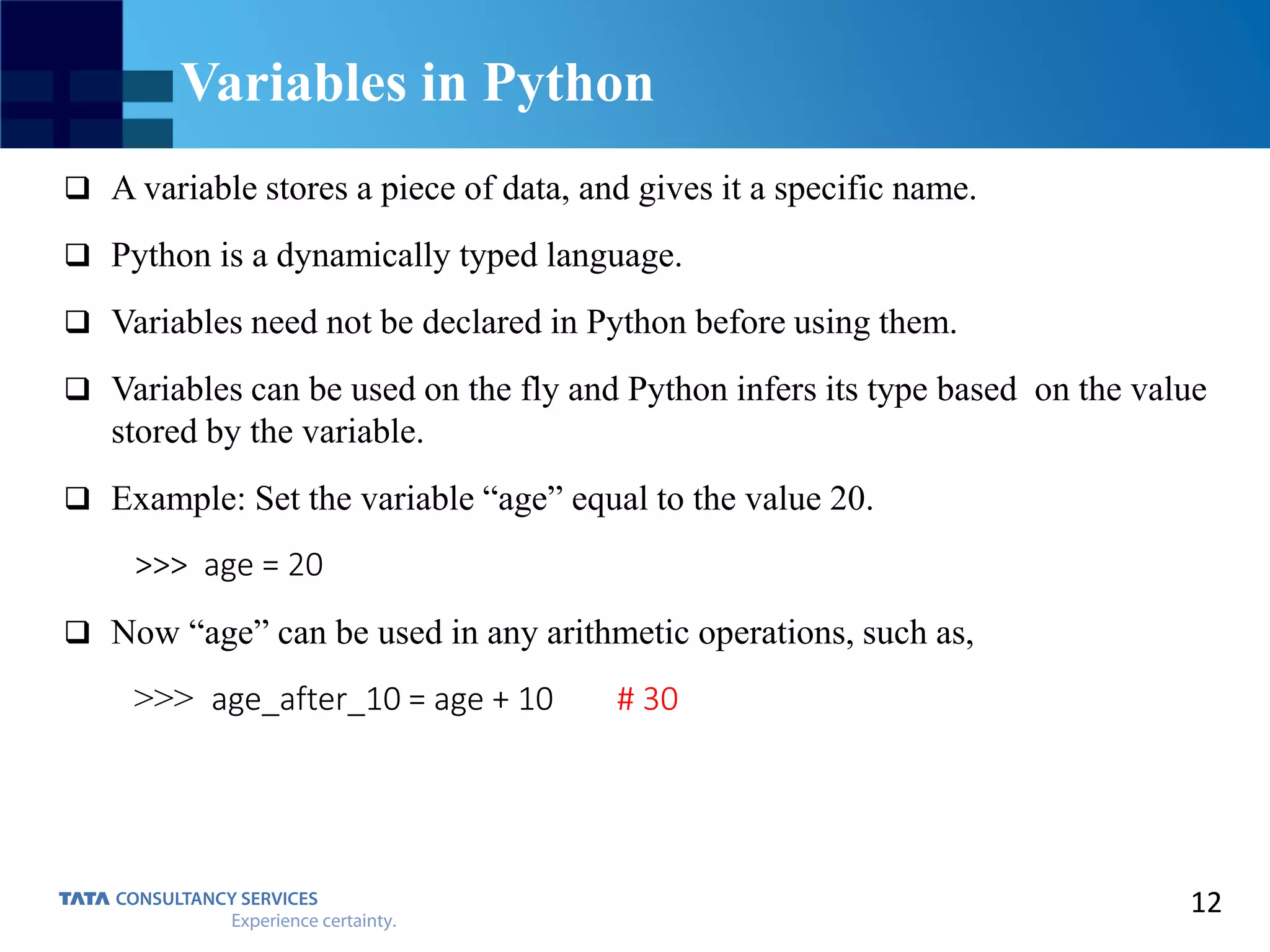
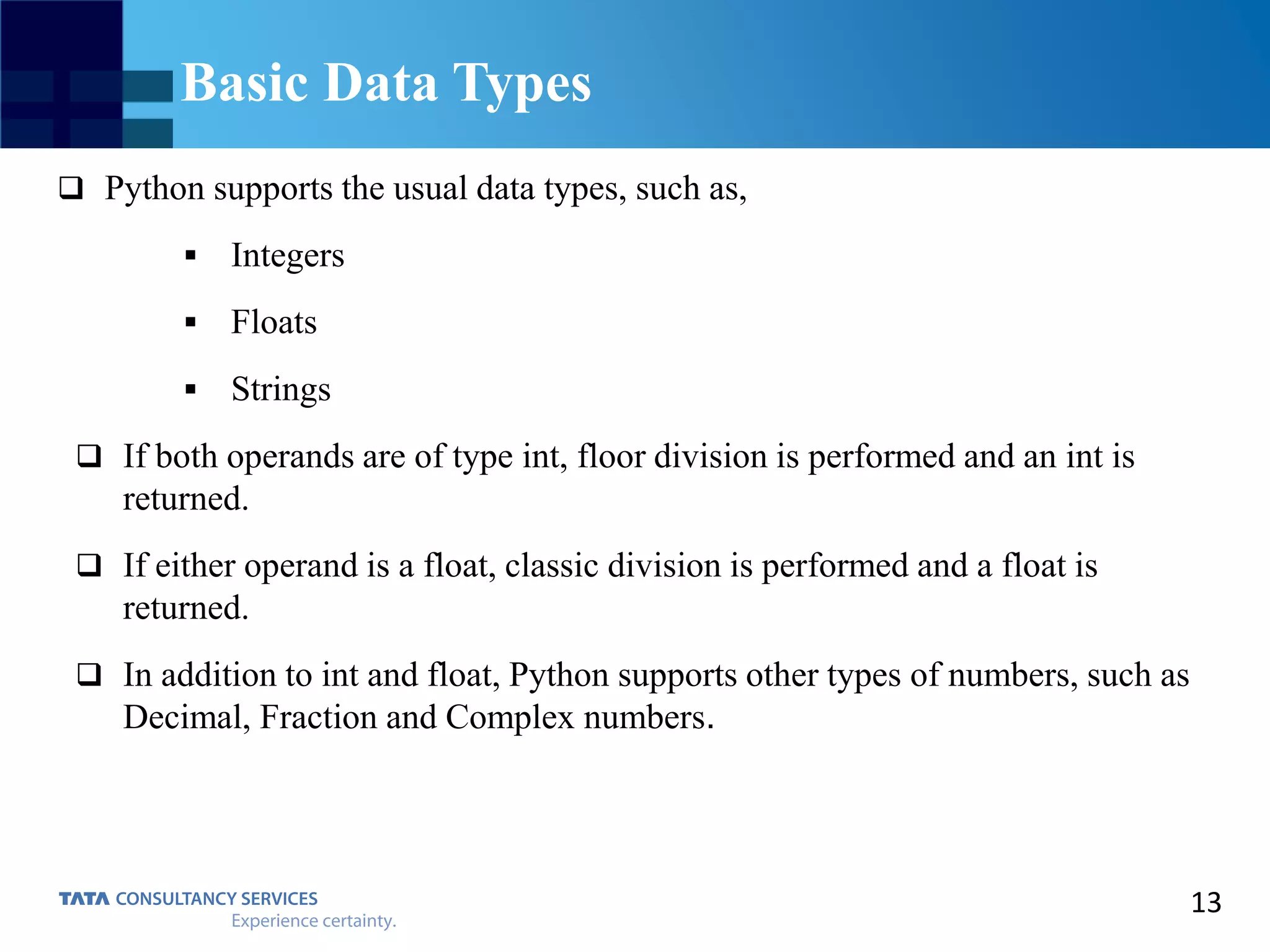
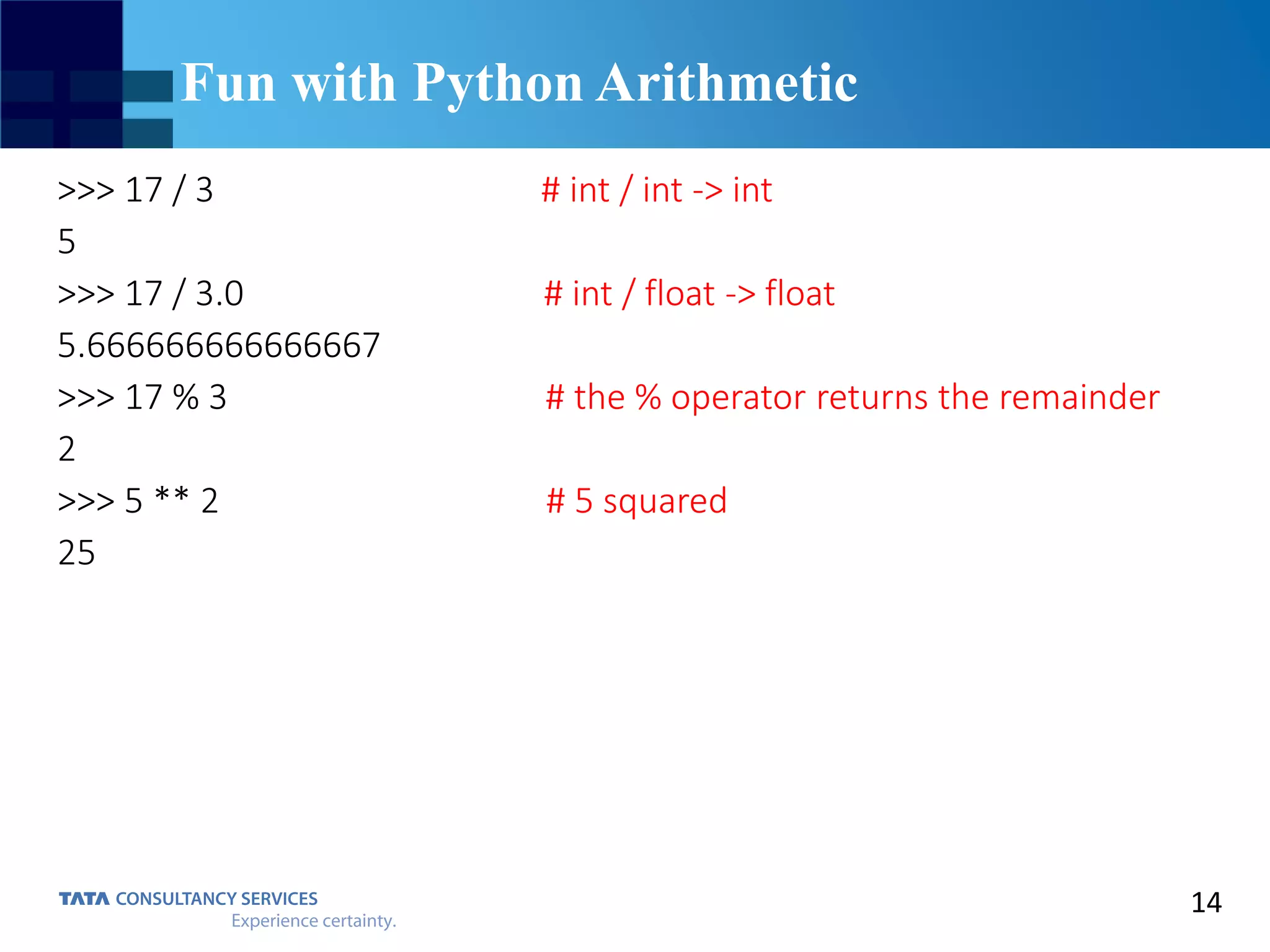
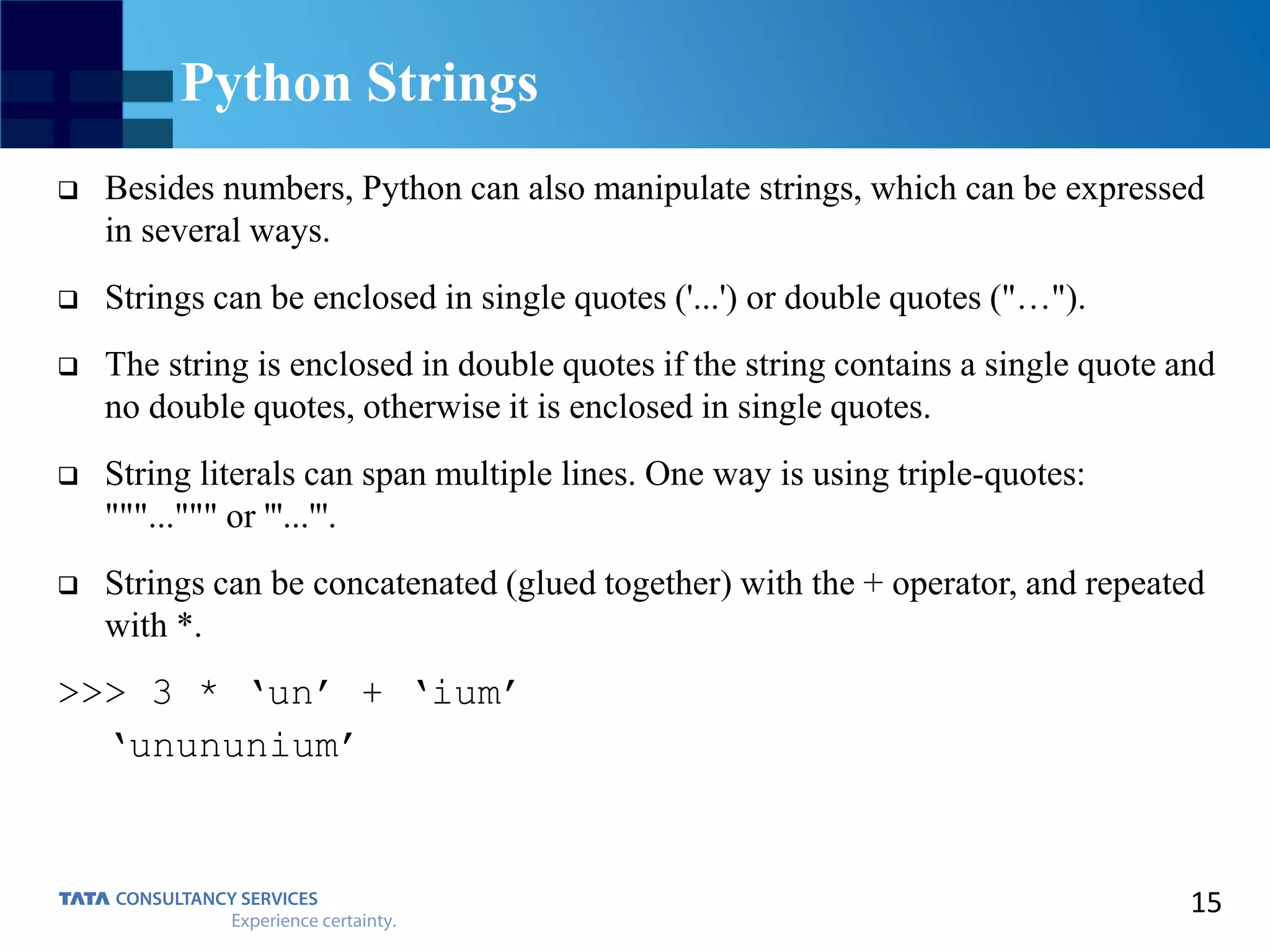
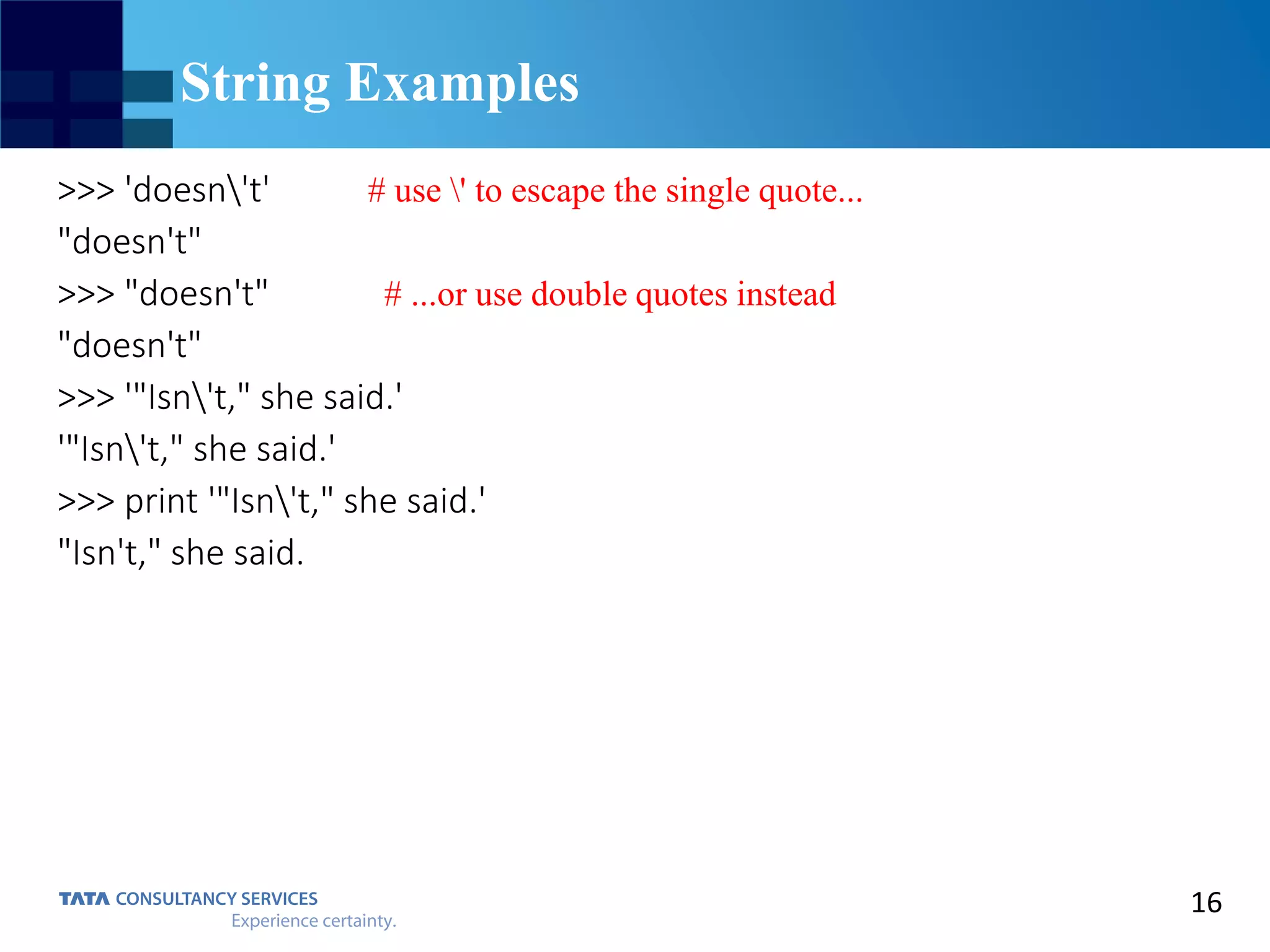
![17 Strings Continued… Strings can be indexed (subscripted), with the first character having index 0. There is no separate character type; a character is simply a string of size one. Indices may also be negative numbers, while counting from the right. Say, word = ‘Python’ >>> word[-1] # last character ‘n’ >>> word[-2] # second last character ‘o’](https://image.slidesharecdn.com/pythoncop-170305112410/75/Intro-to-Python-Programming-Language-17-2048.jpg)
![18 Strings Continued… In addition to indexing, slicing is also supported. While indexing is used to obtain individual characters, slicing allows you to obtain a substring. In slicing, the start is always included, and the end always excluded. This makes sure that s[:i] + s[i:] is always equal to s.](https://image.slidesharecdn.com/pythoncop-170305112410/75/Intro-to-Python-Programming-Language-18-2048.jpg)
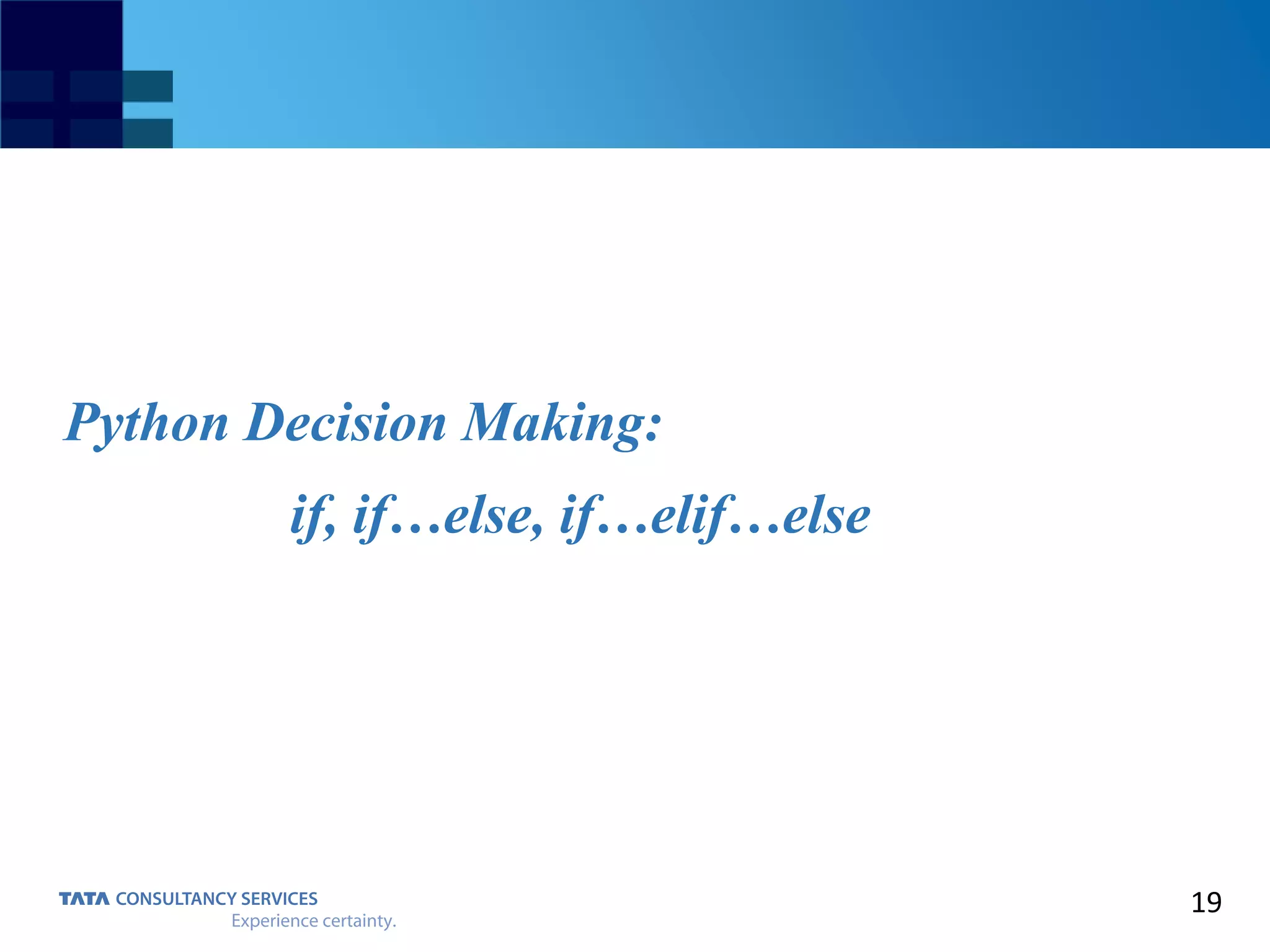
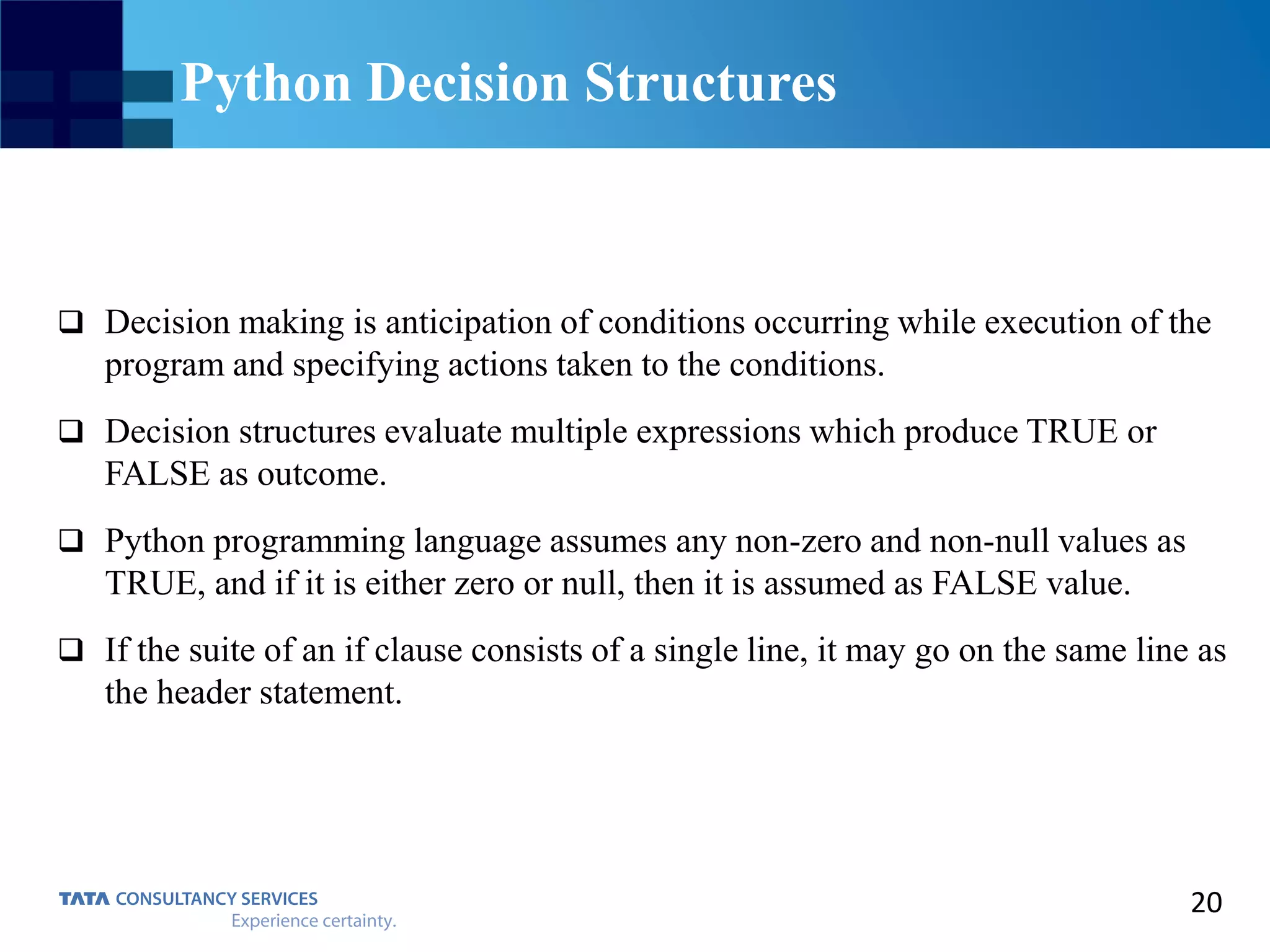
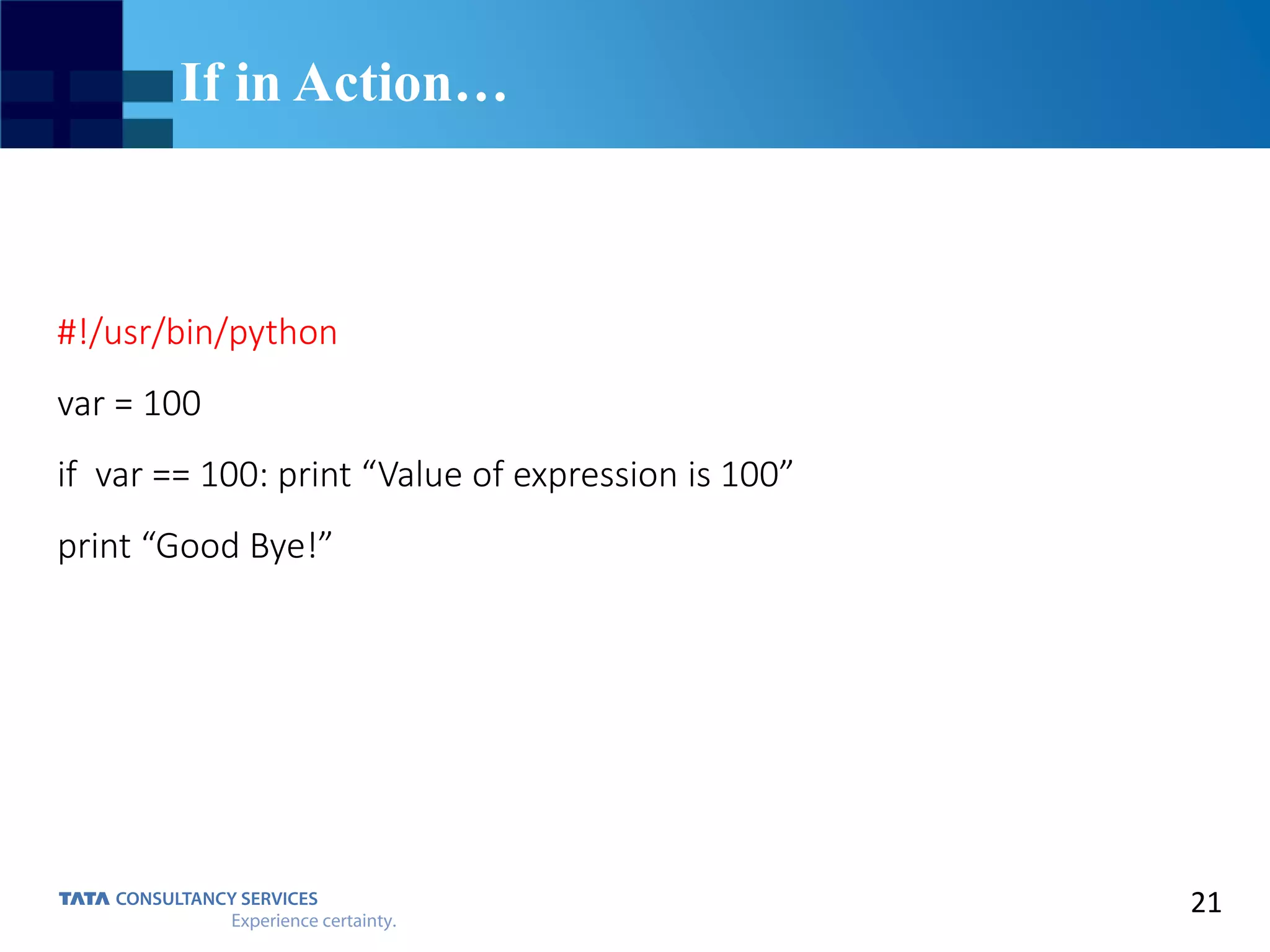
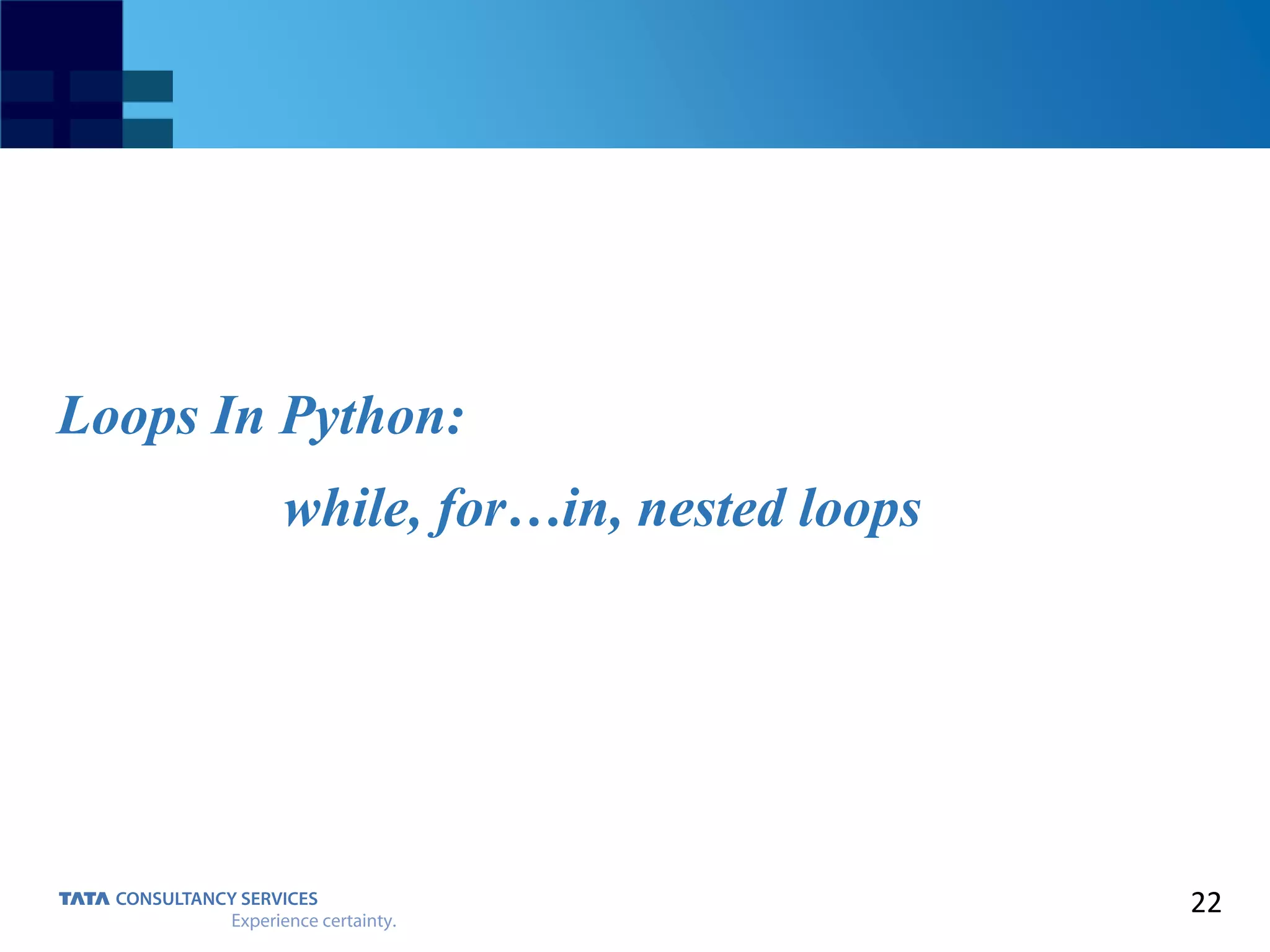
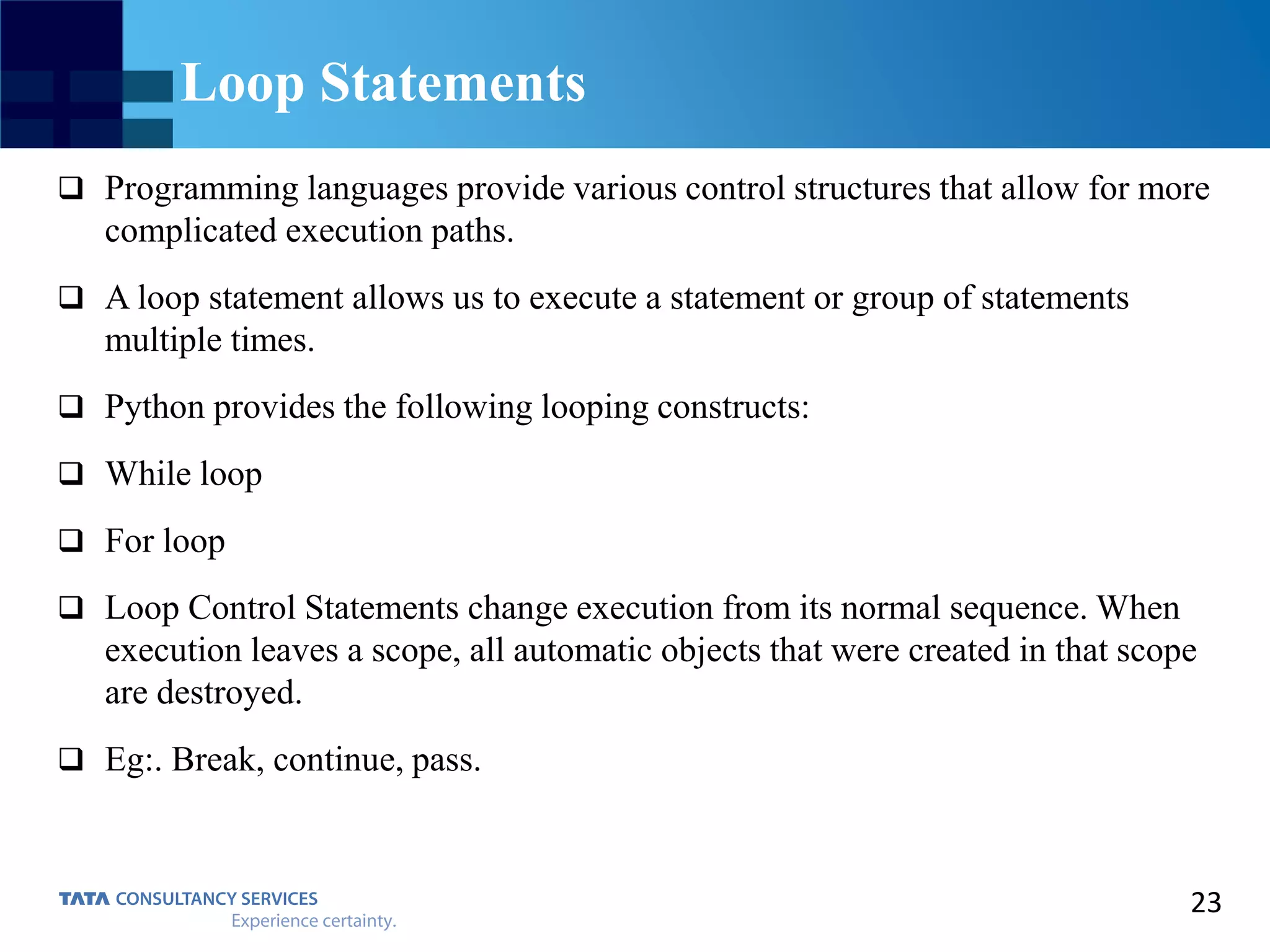
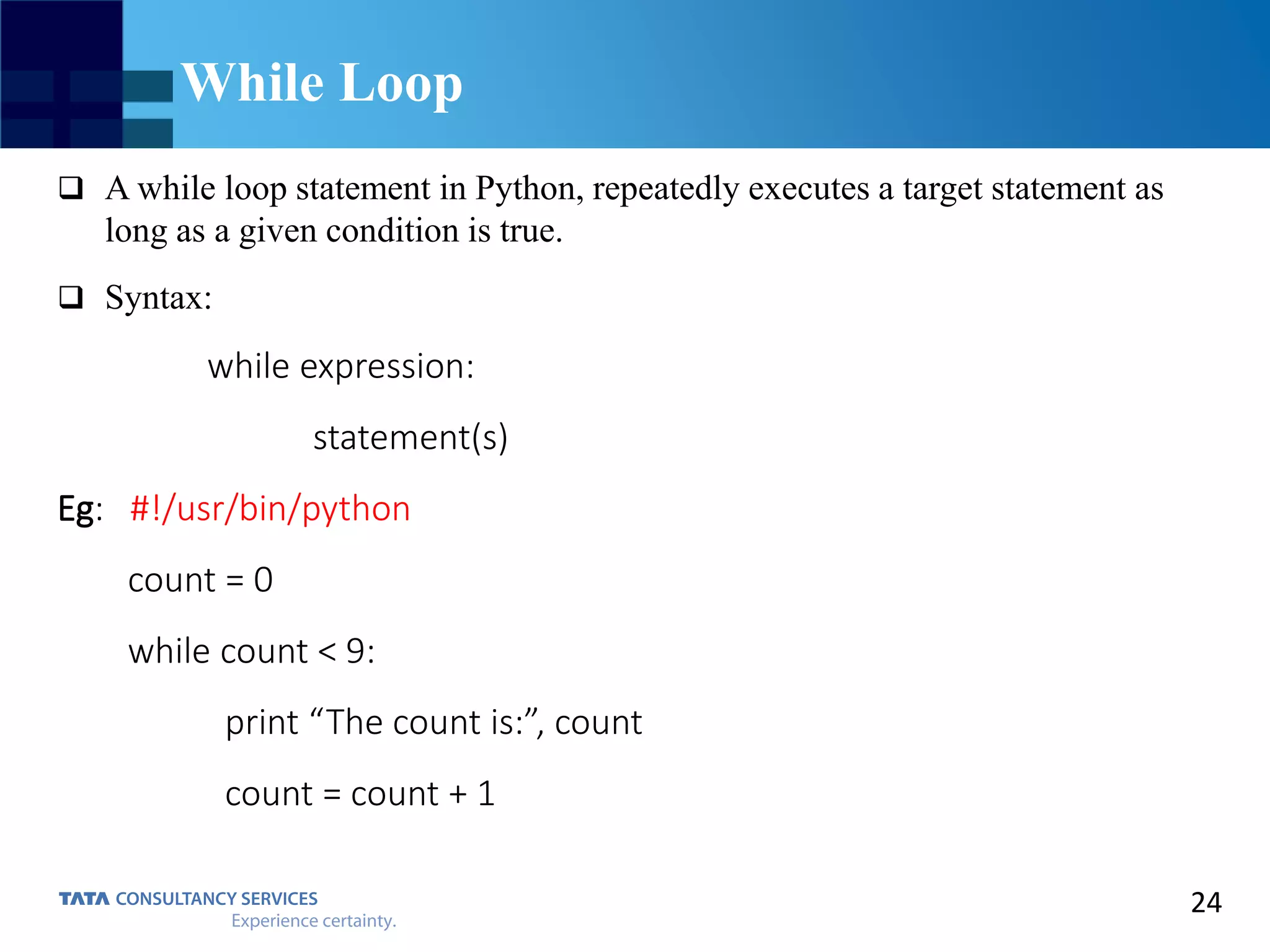
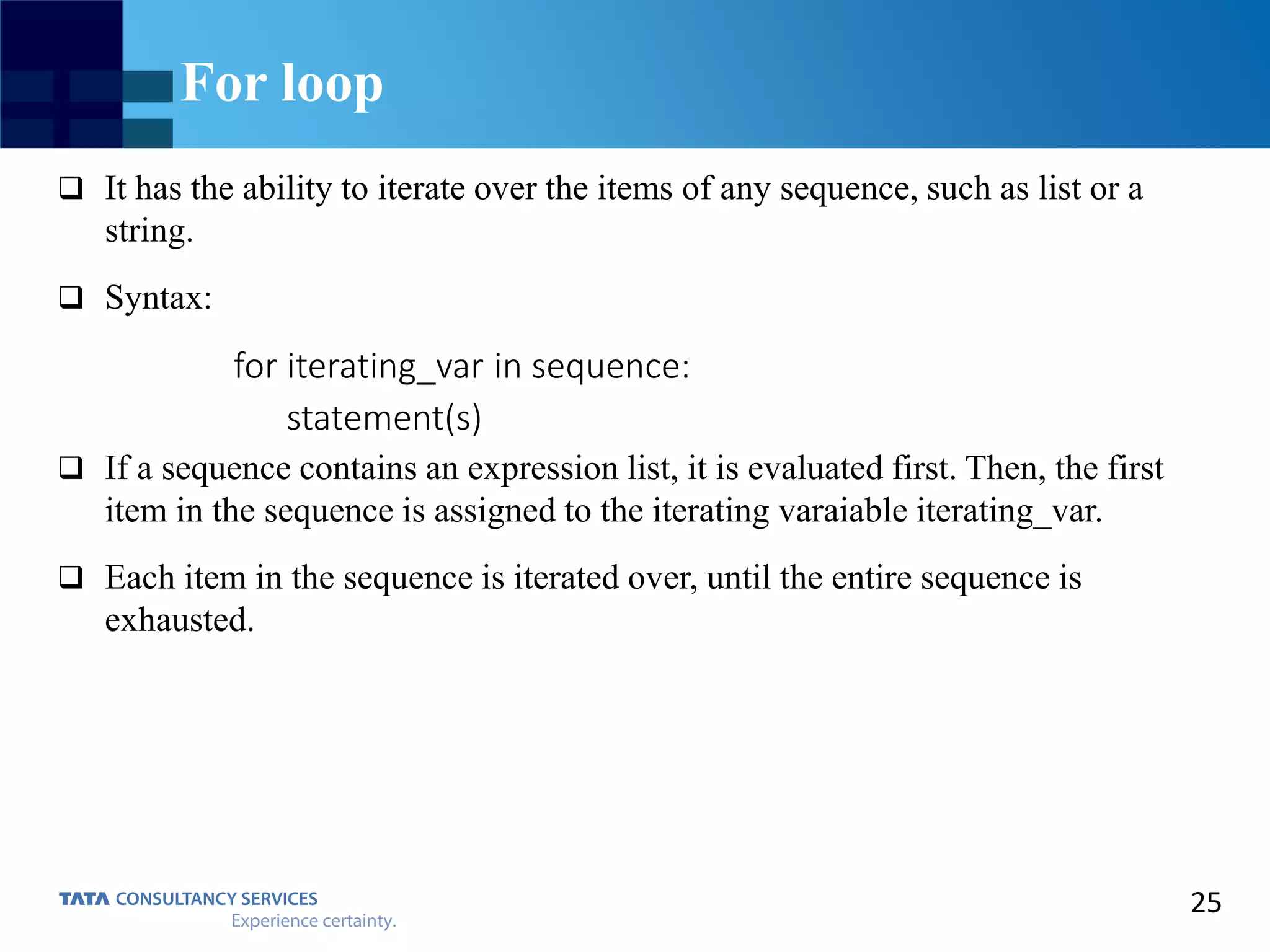
![26 For loop in action… ● Eg:. #!usr/bin/python for letter in ‘Python’: # First Example print ‘Current letter:’, letter Fruits = [‘banana’, ‘apple’, ‘mango’] for fruit in fruits: # Second Example print “Current Fruit:”, fruit](https://image.slidesharecdn.com/pythoncop-170305112410/75/Intro-to-Python-Programming-Language-26-2048.jpg)
![27 Iterating by sequence index An alternative way of iterating through each item is by index offset into the sequence itself. Eg:. fruits = [“banana”, “apple”, “mango”] for index in range(len(fruits)): print “Current fruit:”, fruits[index] In the above example, we took assistance of the len() built-in function, which provides the total number of elements in the tuple as well as the range() built-in function to give us the actual sequence to iterate over.](https://image.slidesharecdn.com/pythoncop-170305112410/75/Intro-to-Python-Programming-Language-27-2048.jpg)
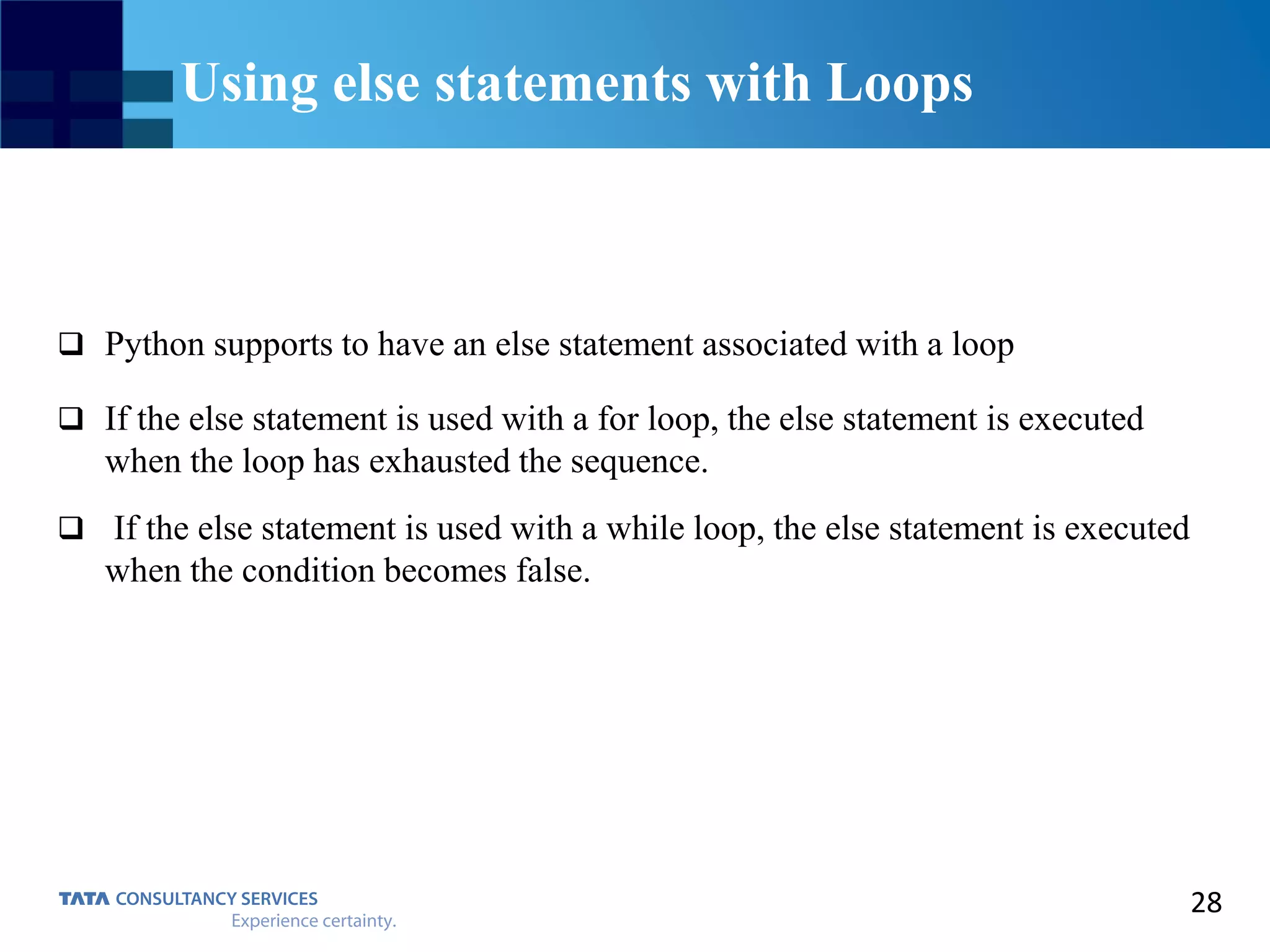
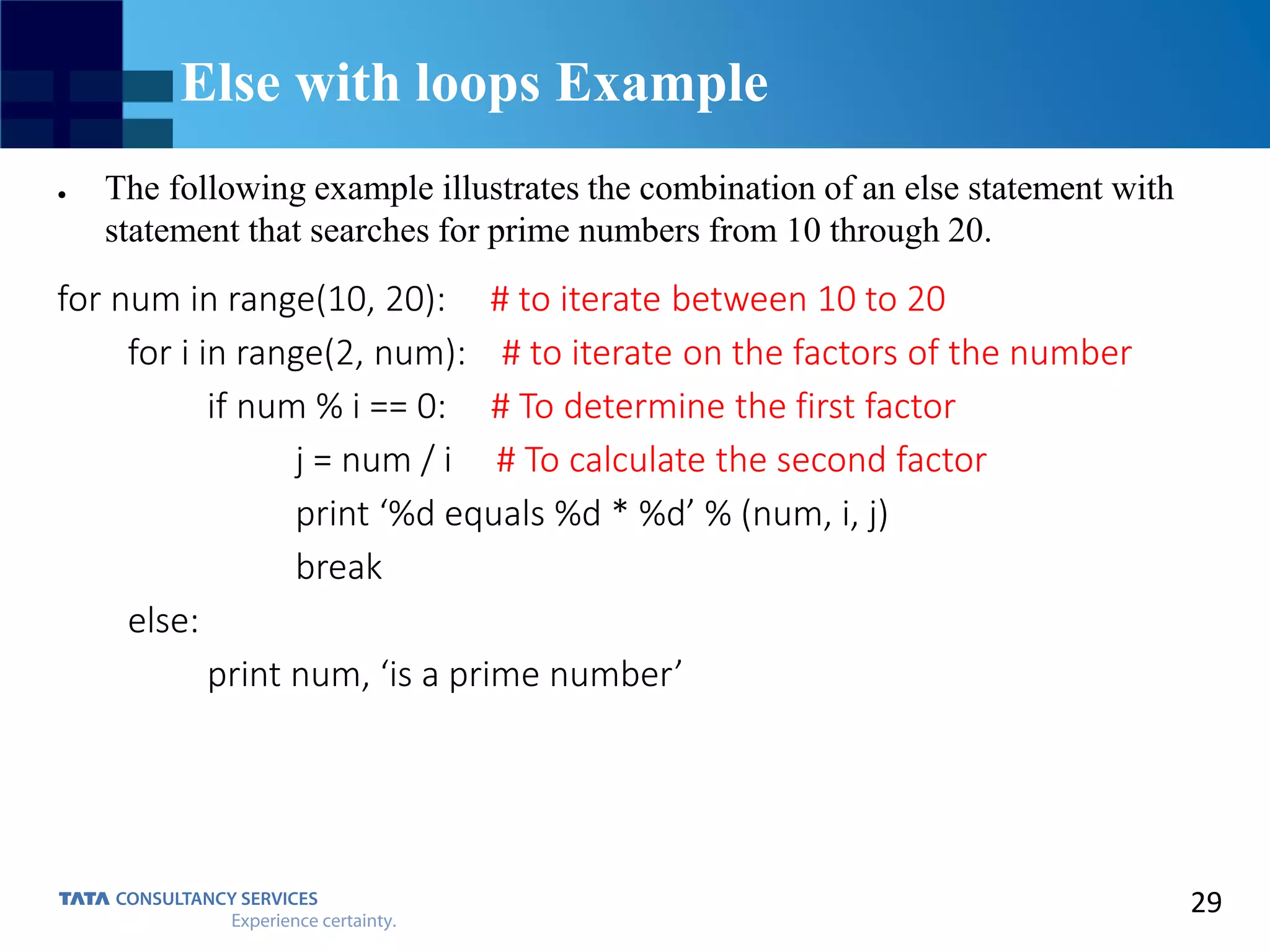
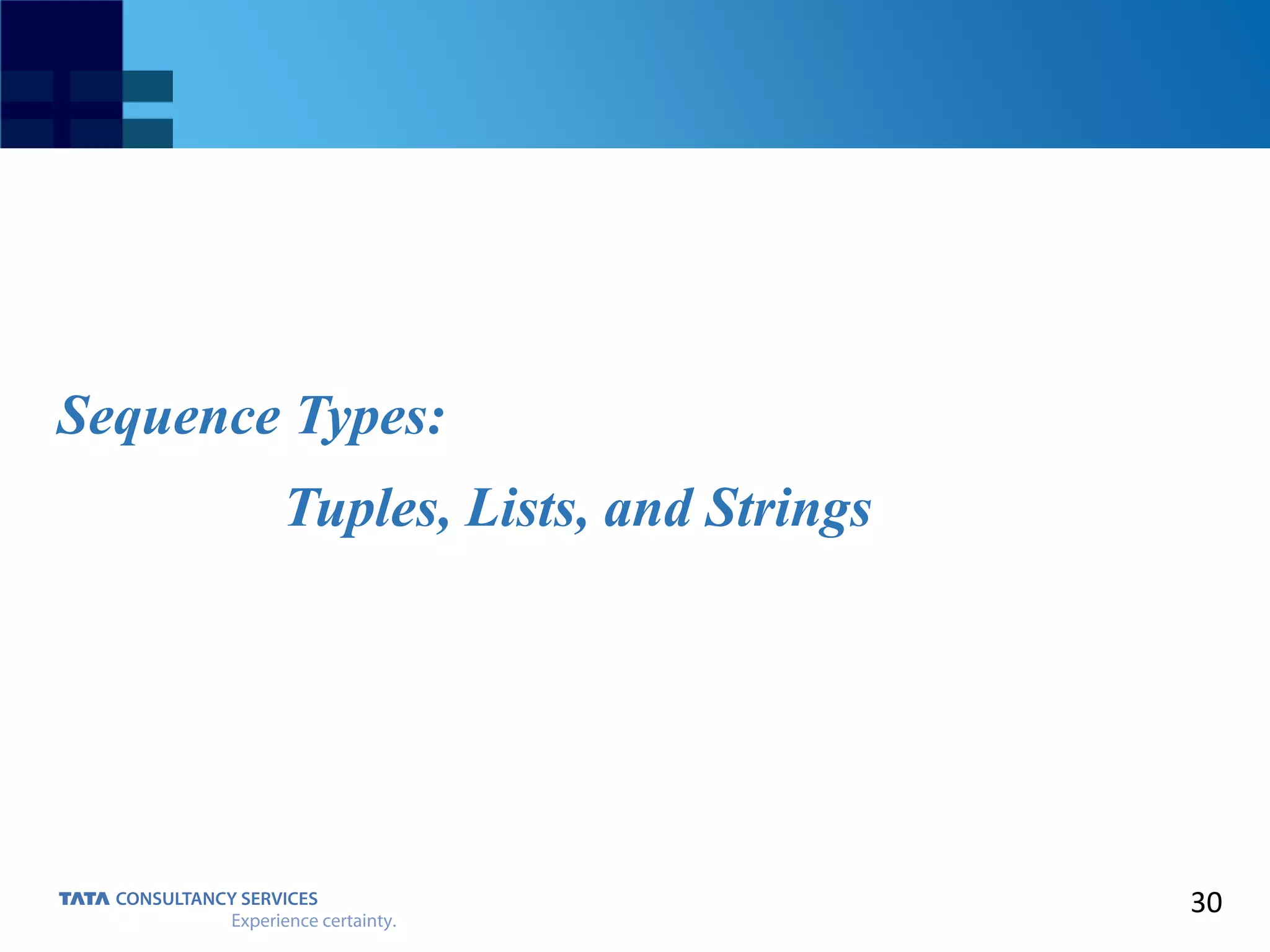
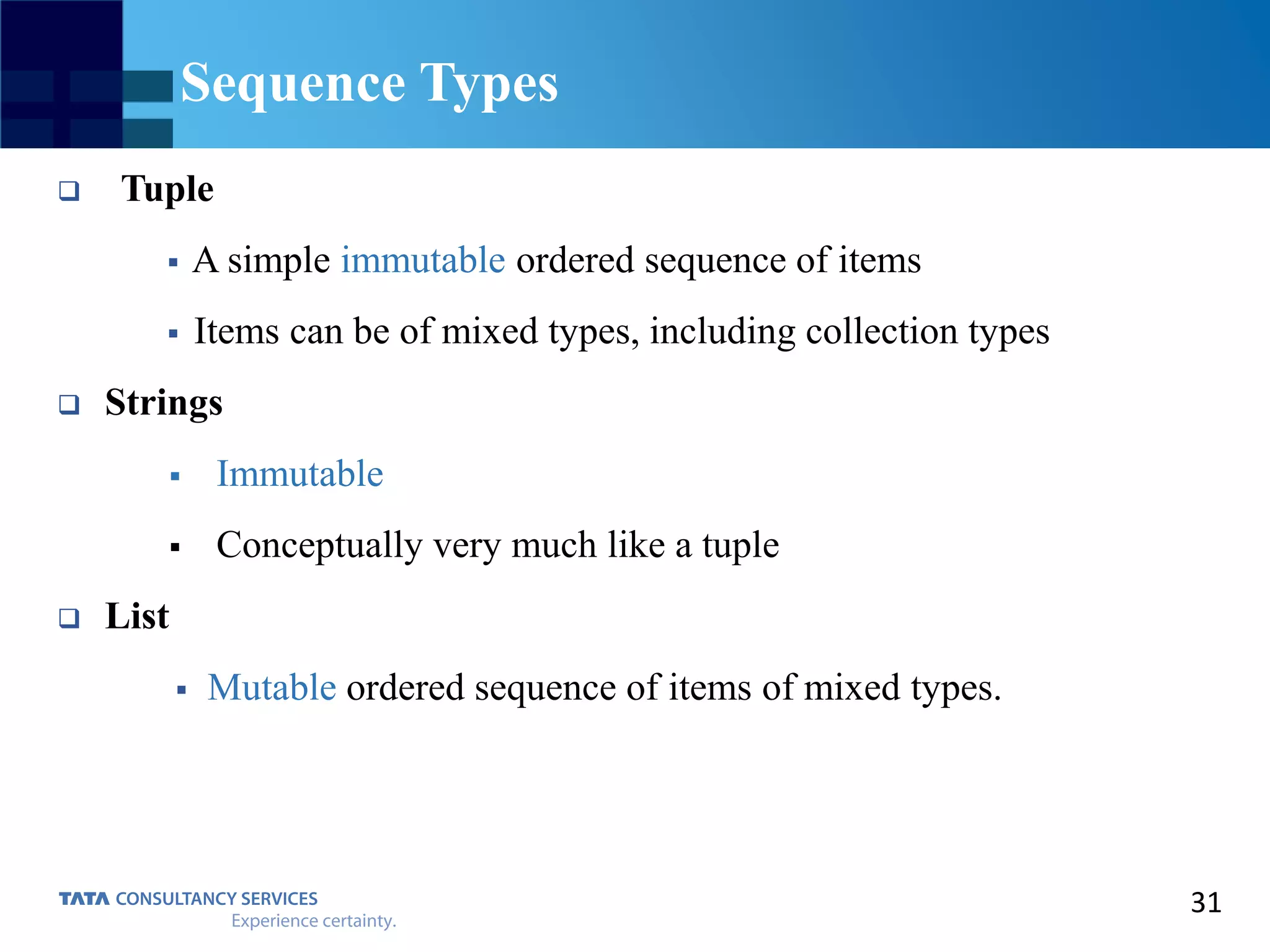
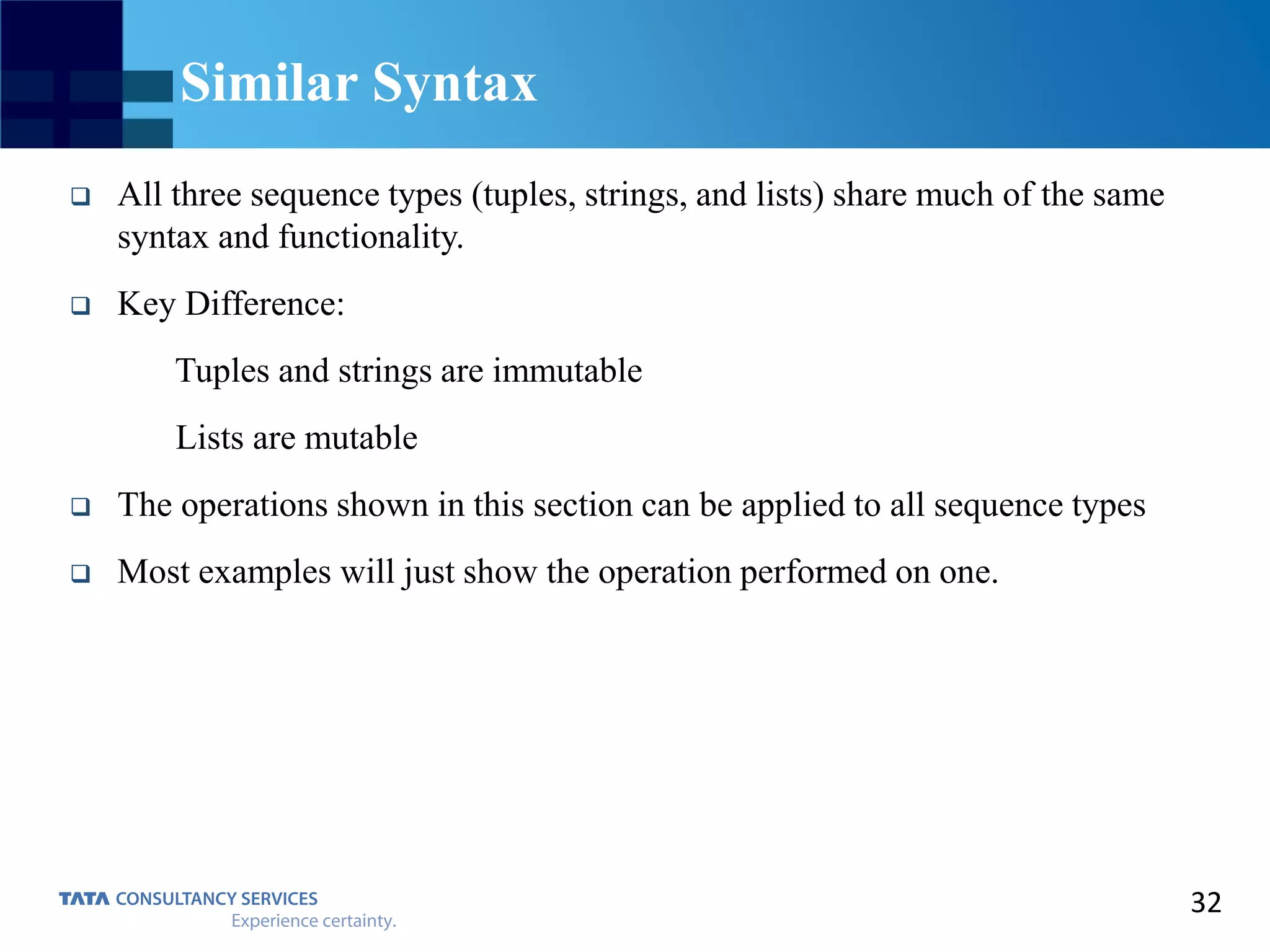
![33 Sequence Types 1 Tuples are defined using parentheses (and commas). >>> tu = (23, ‘abc’, 4.56, (2,3), ‘def’) Lists are defined using square brackets (and commas). >>> li = [“abc”, 34, 4.34, 23] Strings are defined using quotes (“, ‘, or “””). >>> st = “Hello World” >>> st = ‘Hello World’ >>>st = “””This is a multi-line string that uses triple quotes.”””](https://image.slidesharecdn.com/pythoncop-170305112410/75/Intro-to-Python-Programming-Language-33-2048.jpg)
![34 Sequence Types 2 We can access individual members of a tuple, list, or string using square bracket “array” notation. Note that all are 0 based… >>> tu[1] # Second item in the tuple. ‘abc’ >>> li[1] # Second item in the list. 34 >>> st[1] # Second character in string. ‘e’](https://image.slidesharecdn.com/pythoncop-170305112410/75/Intro-to-Python-Programming-Language-34-2048.jpg)
![35 Positive and Negative Indices >>> t = (23, ‘abc’, 4.56, 2,3), ‘def’) Positive index: count from left, starting with 0. >>> t[1] ‘abc’ Negative lookup: count from right, starting with -1. >>> t[-3] 4.56](https://image.slidesharecdn.com/pythoncop-170305112410/75/Intro-to-Python-Programming-Language-35-2048.jpg)
![36 Slicing: Return Copy of a Subset 1 >>> t = (23, ‘abc’, 4.56, (2,3), ‘def’) Return a copy of the container with a subset of the original members. Start copying at the first index, and stop copying before the second index. >>> t[1:4] (‘abc’, 4.56, (2,3)) You can also use negative indices when slicing. >>> t[1:-1] (‘abc’, 4.56, (2,3))](https://image.slidesharecdn.com/pythoncop-170305112410/75/Intro-to-Python-Programming-Language-36-2048.jpg)
![37 Slicing: Return Copy of a Subset 2 >>> t = (23, ‘abc’, 4.56, (2,3), ‘def’) Omit the first index to make a copy starting from the beginning of the container. >>> t[:2] (23, ‘abc’) Omit the second index to make a copy starting at the first index and going to the end of the container. >>> t[2:] (4.56, (2,3), ‘def’)](https://image.slidesharecdn.com/pythoncop-170305112410/75/Intro-to-Python-Programming-Language-37-2048.jpg)
![38 Copying the Whole Sequence To make a copy of an entire sequence, you can use [:]. >>> t[:] (23, ‘abc’, 4.56, (2,3), ‘def’) Note the difference between these two lines for mutable sequences: >>> list2 = list1 # 2 names refer to 1 ref # Changing one affects both >>> list2 = list1[:] # Two independent copies, two refs](https://image.slidesharecdn.com/pythoncop-170305112410/75/Intro-to-Python-Programming-Language-38-2048.jpg)
![39 The ‘in’ Operator Boolean test whether a value is inside a container: >>> t = [1, 2, 3, 4, 5] >>> 3 in t False >>> 4 in t True >>> 4 not in t False](https://image.slidesharecdn.com/pythoncop-170305112410/75/Intro-to-Python-Programming-Language-39-2048.jpg)
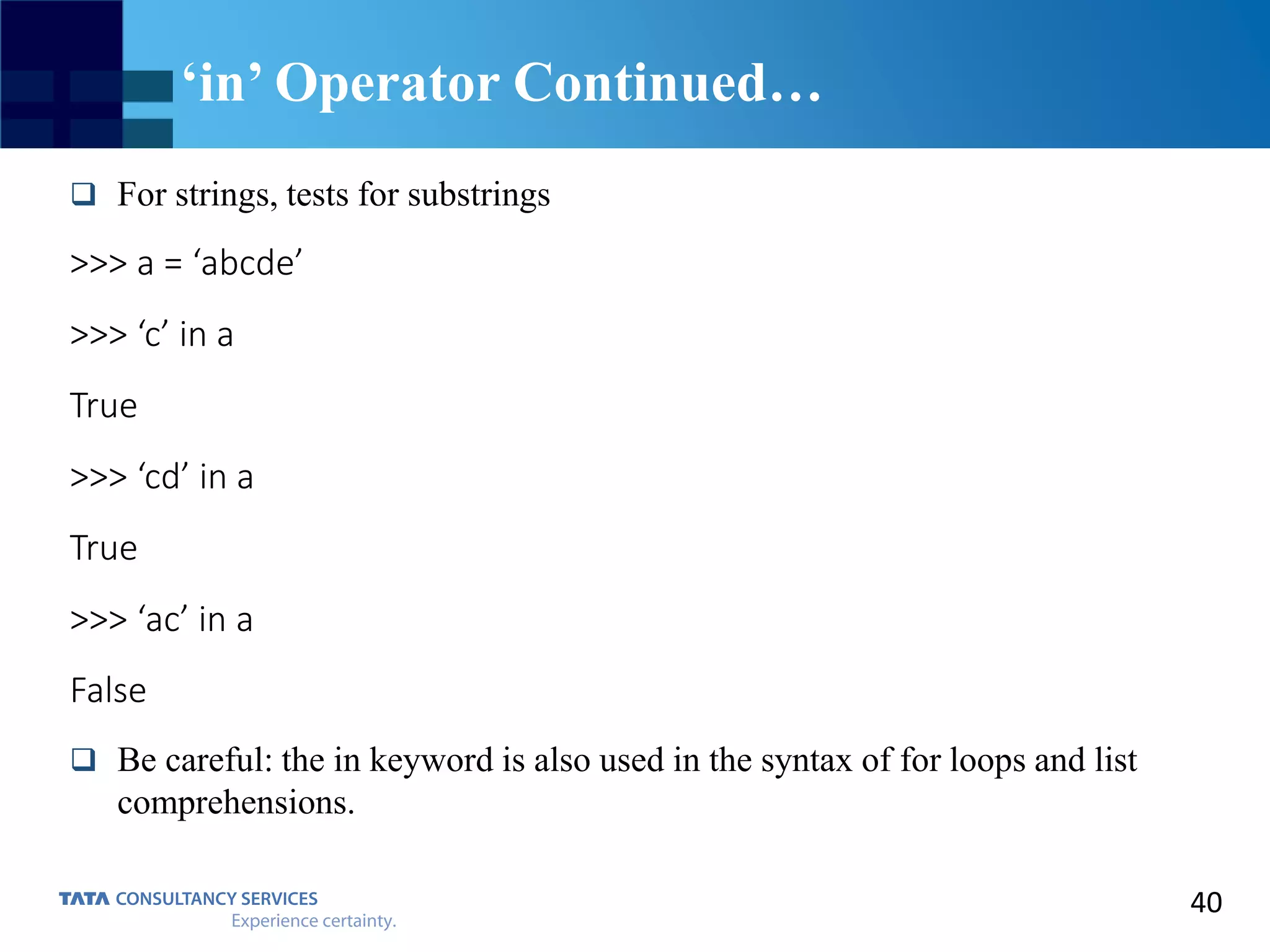
![41 The + Operator The + operator produces a new tuple, list, or string whose value is the concatenation of its arguments. >>> (1, 2, 3) + (4, 5, 6) (1, 2, 3, 4, 5, 6) >>> [1, 2, 3] + [4, 5, 6] [1, 2, 3, 4, 5, 6] >>> “Hello” + “ “ + “World” ‘Hello World’](https://image.slidesharecdn.com/pythoncop-170305112410/75/Intro-to-Python-Programming-Language-41-2048.jpg)
![42 The * Operator The * operator produces a new tuple, list, or string that “repeats” the original content. >>> (1, 2, 3) * 3 (1, 2, 3, 1, 2, 3, 1, 2, 3) >>> [1, 2, 3] * 3 [1, 2, 3, 1, 2, 3, 1, 2, 3] >>> “Hello” * 3 ‘HelloHelloHello’](https://image.slidesharecdn.com/pythoncop-170305112410/75/Intro-to-Python-Programming-Language-42-2048.jpg)
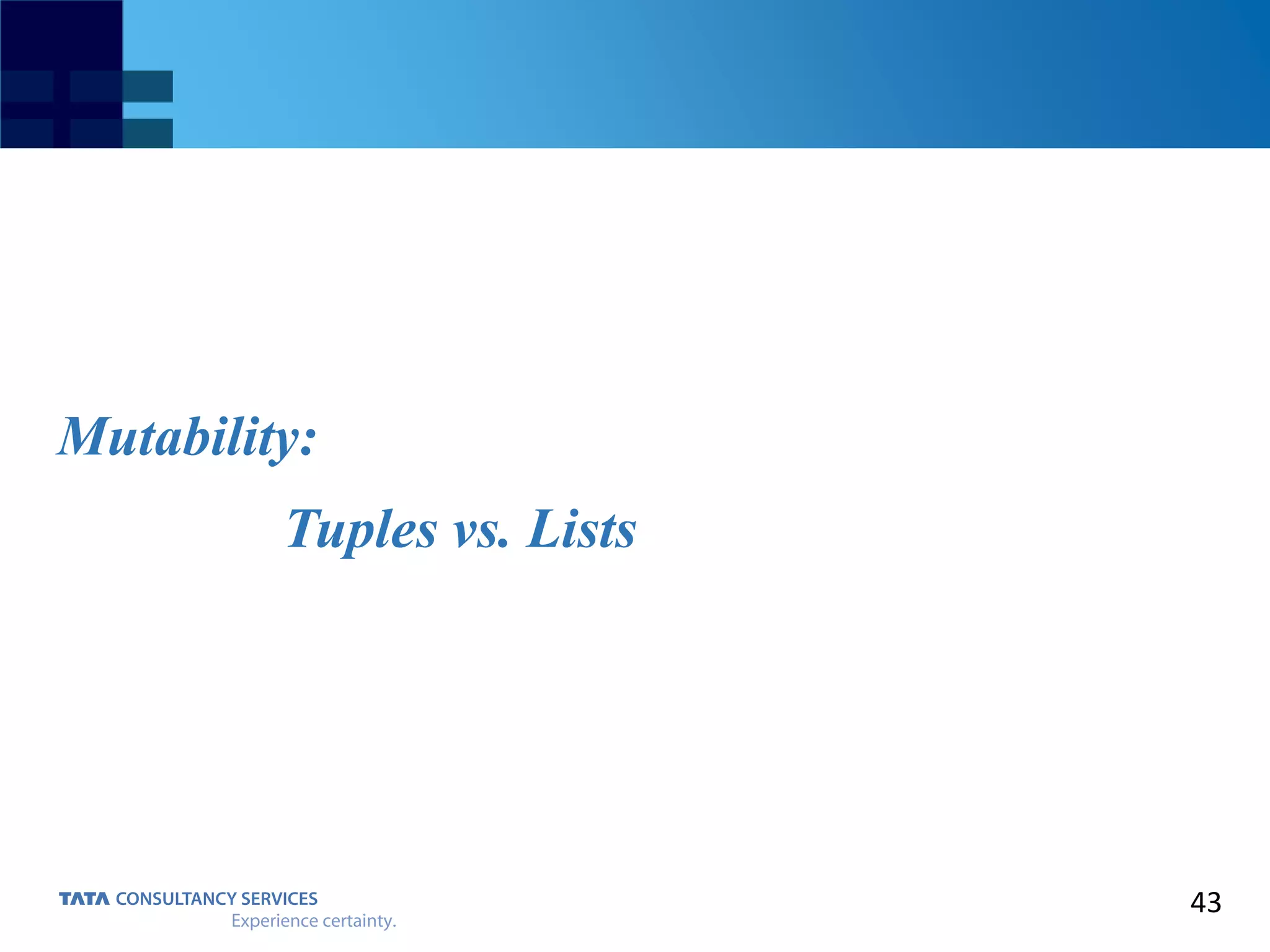
![44 Tuples: Immutable >>> t = (23, ‘abc’, 4.56, (2,3), ‘def) >>> t[2] = 3.14 You can’t change a tuple. You can make a fresh tuple and assign its reference to a previously used name. >>> t = (23, ‘abc’, 3.14, (2,3), ‘def’)](https://image.slidesharecdn.com/pythoncop-170305112410/75/Intro-to-Python-Programming-Language-44-2048.jpg)
![45 Lists: Mutable >>> li = [‘abc’, 23, 4.34, 23] >>> li[1] = 45 >>> li [‘abc’, 45, 4.34, 23] We can change lists in place. Name li still points to the same memory reference when we’re done. The mutability of lists means that they aren’t as fast as tuples.](https://image.slidesharecdn.com/pythoncop-170305112410/75/Intro-to-Python-Programming-Language-45-2048.jpg)
![46 Operations on lists Only 1 >>> li = [1, 11, 3, 4, 5] >>> li.append(‘a’) # Our first exposure to method syntax >>> li [1, 11, 3, 4, 5, ‘a’] >>> li.insert(2, ‘i’) >>> li [1, 11, ‘i’, 3, 4, 5, ‘a’]](https://image.slidesharecdn.com/pythoncop-170305112410/75/Intro-to-Python-Programming-Language-46-2048.jpg)
![47 The extend method vs the + operator ‘+’ creates a fresh list (with a new memory reference) Extend operates on list li in place. >>> li.extend([9, 8, 7]) >>> li [1, 2, ‘i’, 3, 4, 5, ‘a’, 9, 8, 7] Confusing: • Extend takes a list as an argument. • Append takes a singleton as an argument. >>> li.append([10, 11, 12])](https://image.slidesharecdn.com/pythoncop-170305112410/75/Intro-to-Python-Programming-Language-47-2048.jpg)
![48 Operations on Lists Only 3 >>> li = [‘a’, ‘b’, ‘c’, ‘b’] >>> li.index(‘b’) # index of first occurrence 1 >>> li.count(‘b’) # number of occurences 2 >>> li.remove(‘b’) # remove first occurrence >>> li [‘a’, ‘c’, ‘b’]](https://image.slidesharecdn.com/pythoncop-170305112410/75/Intro-to-Python-Programming-Language-48-2048.jpg)
![49 Operations on Lists Only 4 >>> li = [5, 2, 6, 8] >>> li.reverse() # reverse the list *in place* >>> li [8, 6, 2, 5] >>> li.sort() # sort the list *in place* >>> li [2, 5, 6, 8] >>> li.sort(some_function) # sort in place using user-defined comparison](https://image.slidesharecdn.com/pythoncop-170305112410/75/Intro-to-Python-Programming-Language-49-2048.jpg)
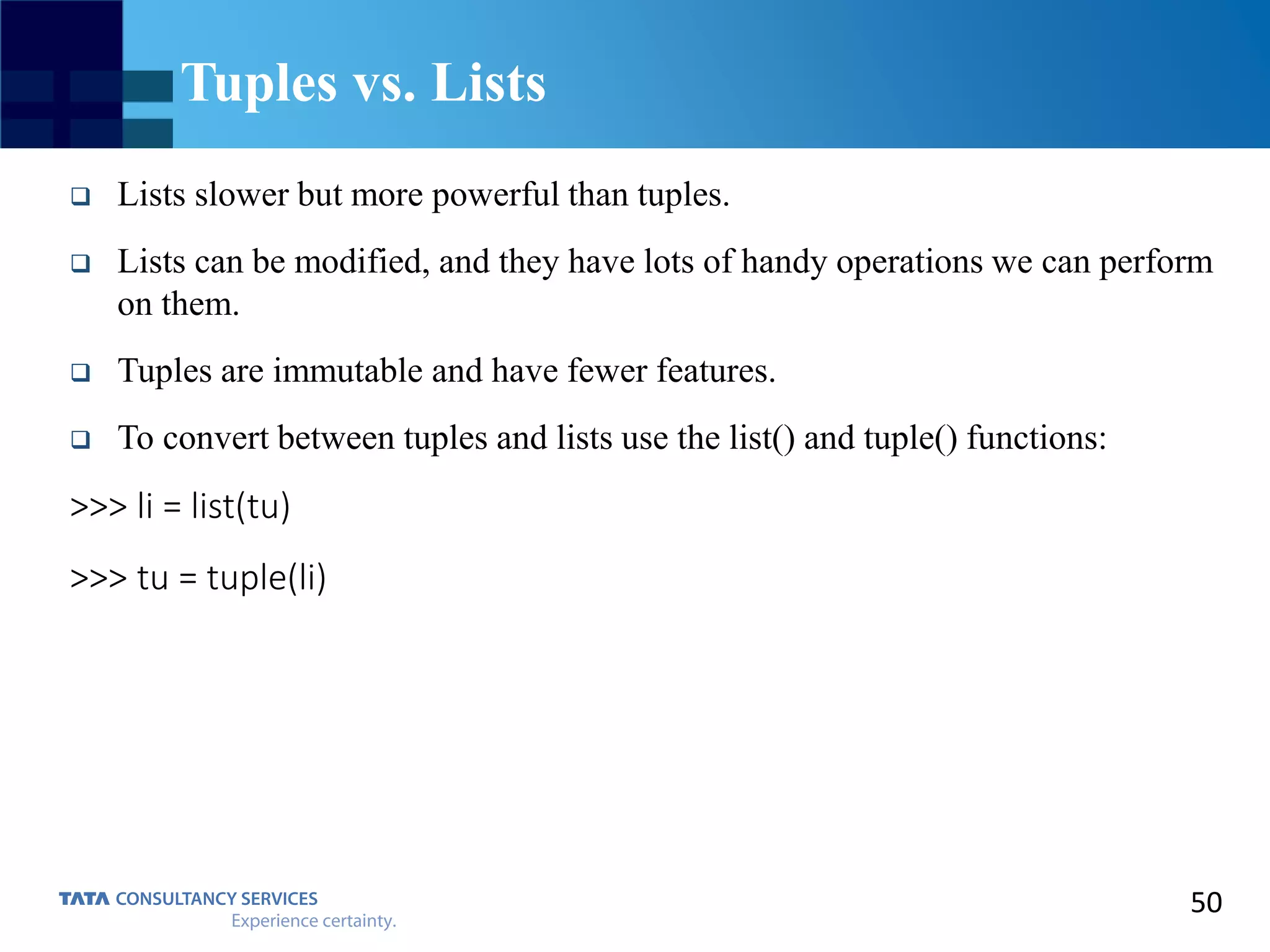
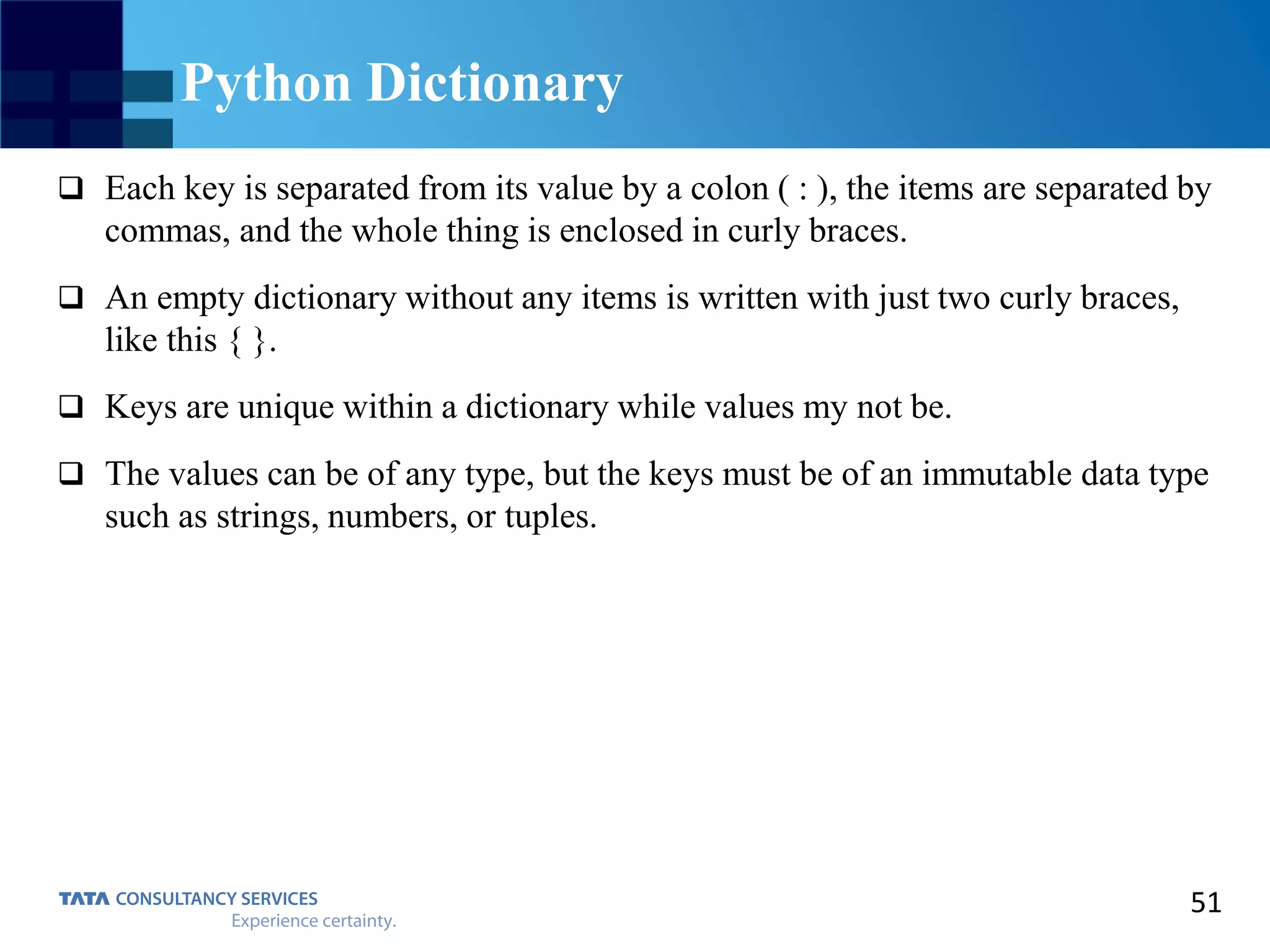
![52 Accessing Values in a Dictionary To access dictionary elements, we can use the familiar square brackets along with the key to obtain its value. Eg:. dict = {‘Name’: ‘Zara’, ‘Age’: 7, ‘Class’: ‘First’} print dict[‘Name’] print dict[‘Age’] If we attempt to access a data item with a key, which is not part of the dictionary, we will get an error.](https://image.slidesharecdn.com/pythoncop-170305112410/75/Intro-to-Python-Programming-Language-52-2048.jpg)
![53 Updating Dictionary We can update a dictionary by adding a new entry or key-value pair, modifying an existing entry, or deleting an existing entry. Eg:. dict = {‘Name’: ‘Zara’, ‘Age’: 7, ‘Class’: ‘First’} dict[‘Age’] = 8 # Update existing entry dict[‘School’] = “DPS School” # Add new entry](https://image.slidesharecdn.com/pythoncop-170305112410/75/Intro-to-Python-Programming-Language-53-2048.jpg)
![54 Delete Dictionary Elements We can either remove individual dictionary elements or clear the entire contents of a dictionary. We can also delete the entire dictionary in a single operation. To explicitly remove an entire dictionary, just use the del statement. dict = {‘Name’: ‘Zara’, ‘Age’: 7, ‘Class’: ‘First’} del dict[‘Name’] # Delete an element dict.clear() # Clear the contents of the dictionary del dict # Remove the entire dictionary structure.](https://image.slidesharecdn.com/pythoncop-170305112410/75/Intro-to-Python-Programming-Language-54-2048.jpg)
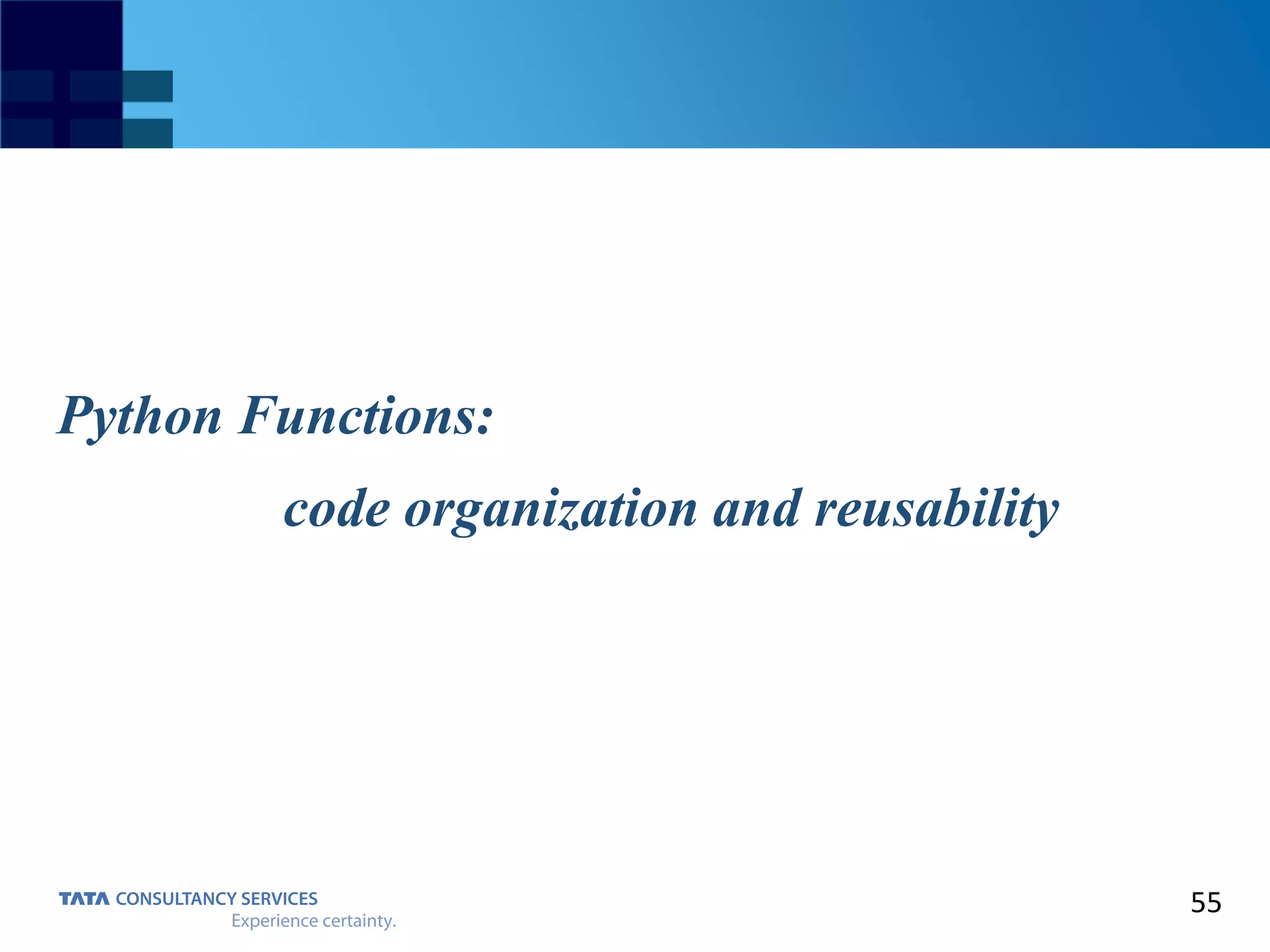
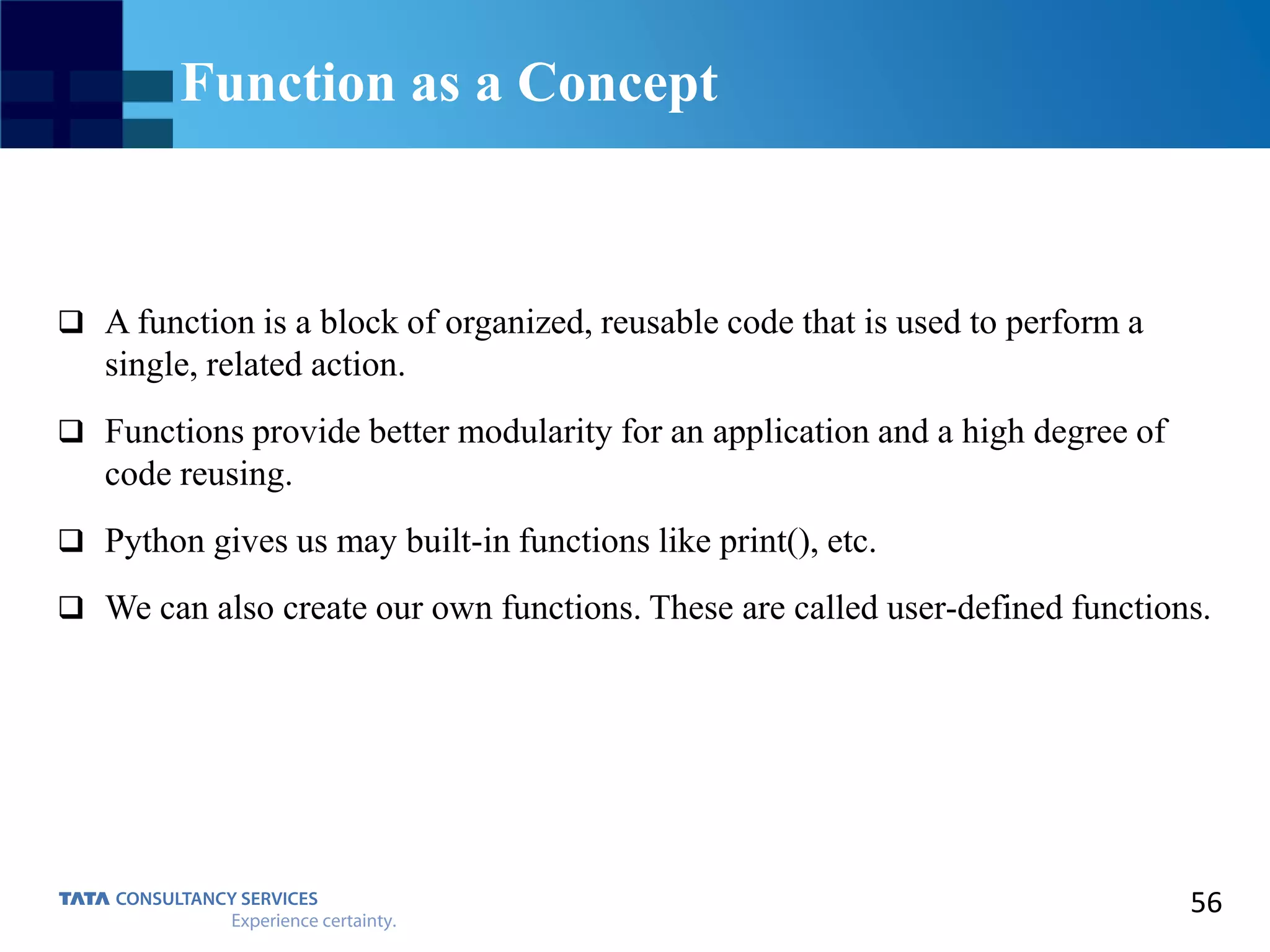
![57 Defining a Function Function blocks begin with the keyword def followed by the function name and parentheses. Any input parameters or arguments should be placed within these parentheses. We can also define parameters inside these parentheses. The first statement of a function can be an optional statement – the documentation string of the function or docstring. The code block within every function starts with a colon ( : ) and is indented. The statement return [expression] exits a function, optionally passing back an expression to the caller. A return statement with no arguments is the same as return None.](https://image.slidesharecdn.com/pythoncop-170305112410/75/Intro-to-Python-Programming-Language-57-2048.jpg)
![58 Function Structure def function_name ( parameters ): “function_docstring” function_suite return [expression] Eg:. def printme (str): “This prints a passed string into this function” print str return](https://image.slidesharecdn.com/pythoncop-170305112410/75/Intro-to-Python-Programming-Language-58-2048.jpg)
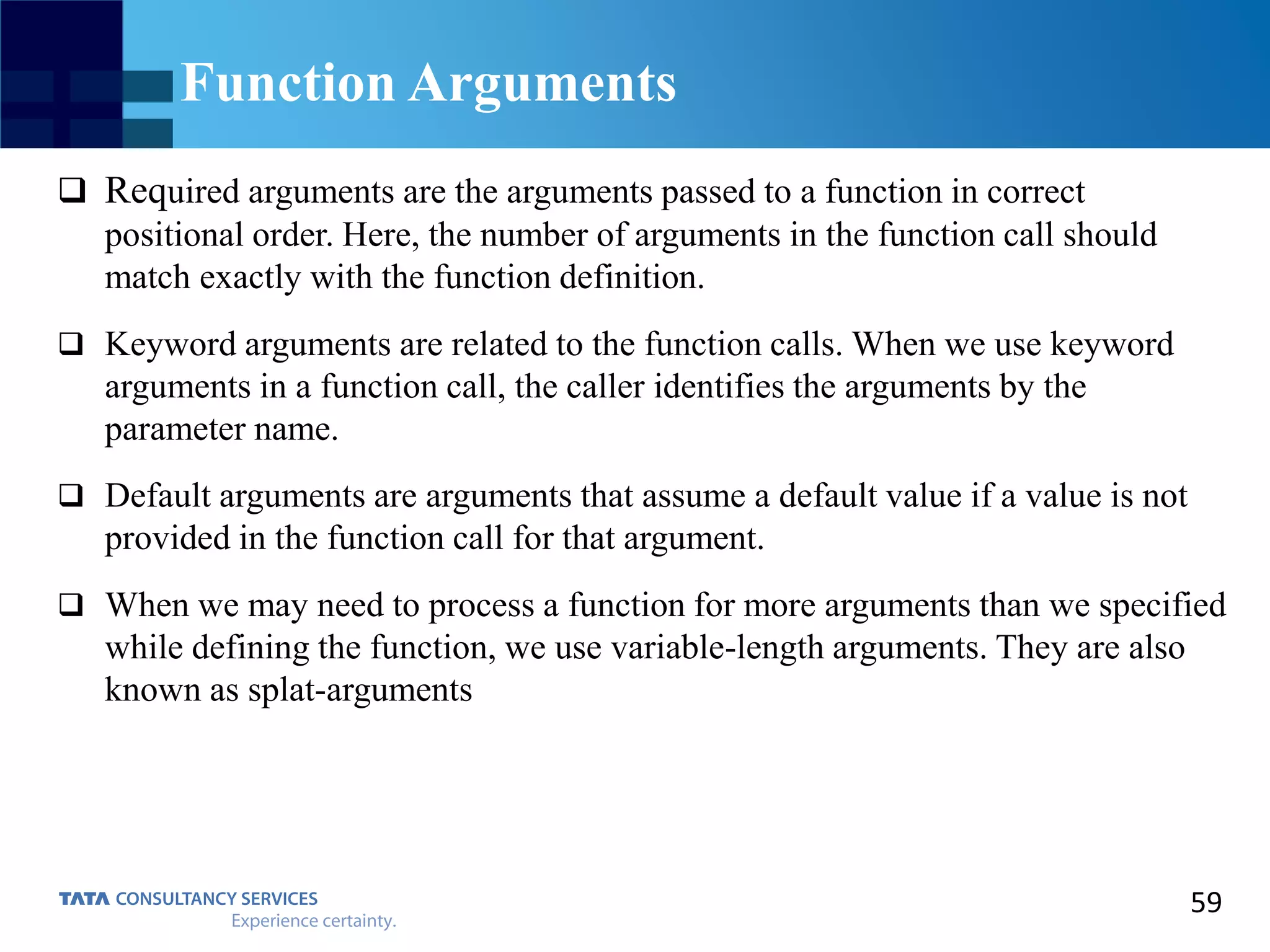
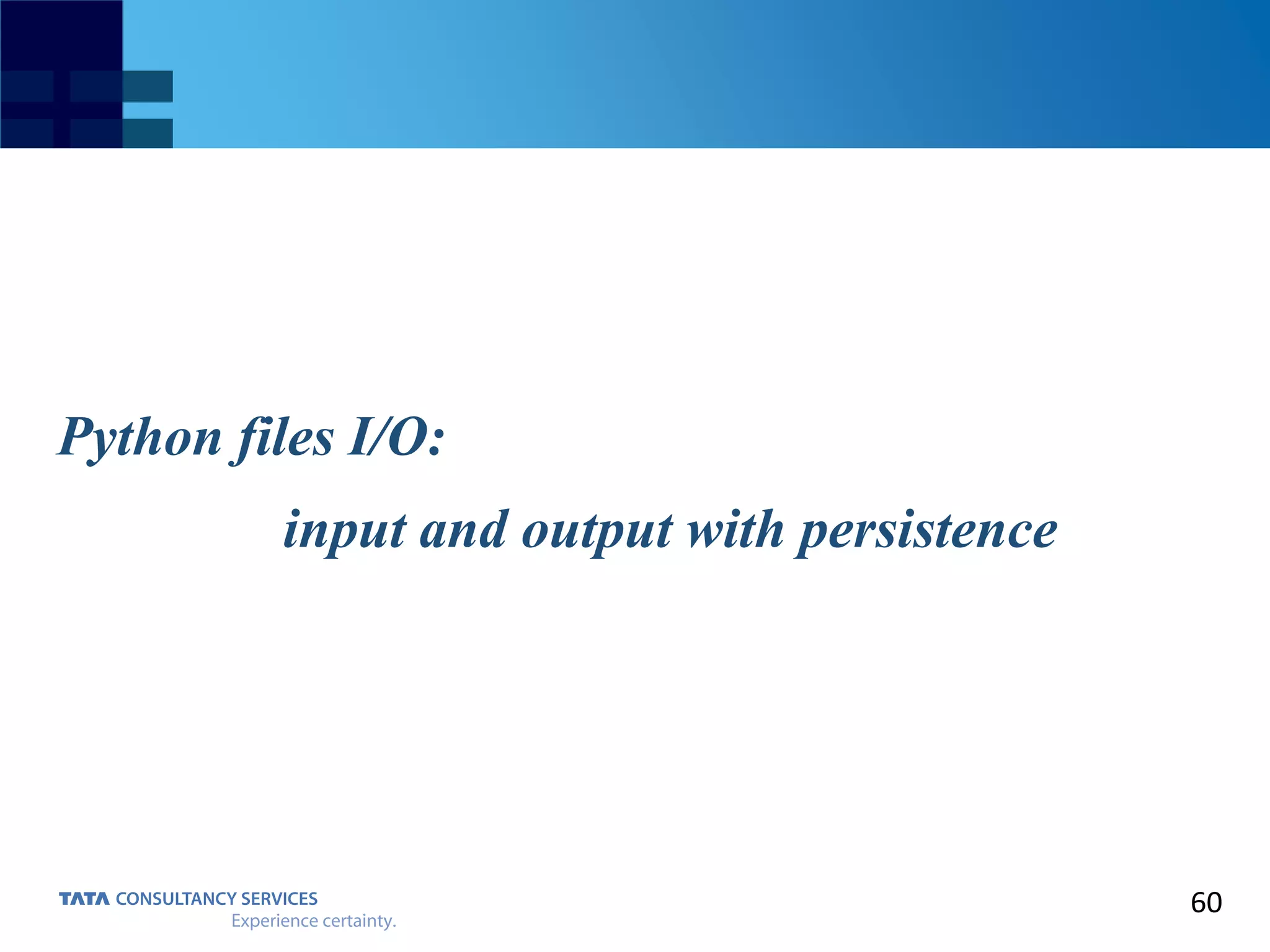
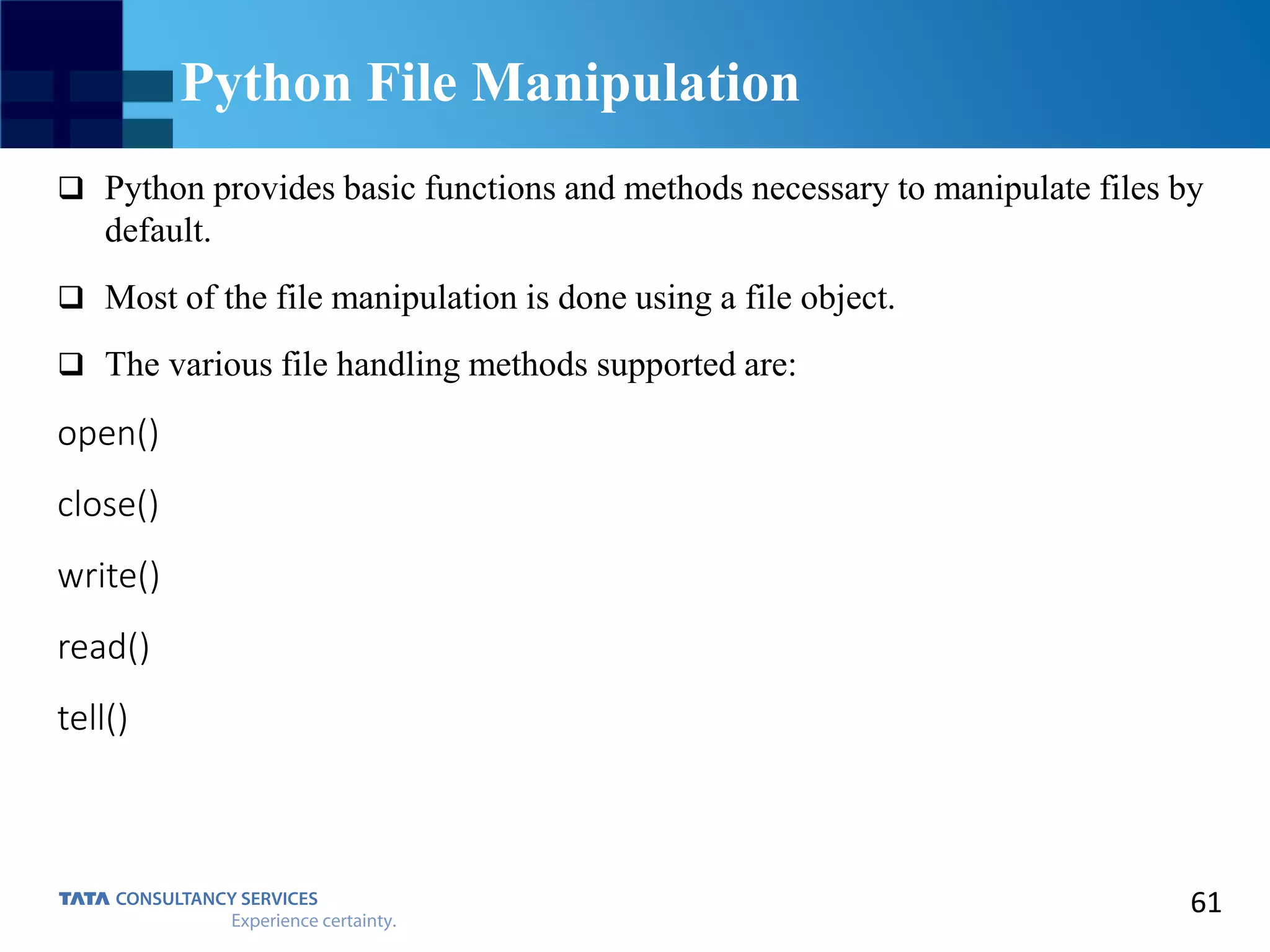
![62 The open() Function Before we can read or write to a file, we have to open it. This function creates a file object, which would be utilized to call other support methods associated with it. Syntax: file_object = open(file_name [, access_mode][, buffering]) The commonly used access modes are ‘r’, ‘rb’, ‘r+’, ‘rb+’, ‘w’, ‘wb’, ‘w+’, ‘wb+’ and ‘a’. Eg:. fo = open(“foo.txt”, “wb”)](https://image.slidesharecdn.com/pythoncop-170305112410/75/Intro-to-Python-Programming-Language-62-2048.jpg)
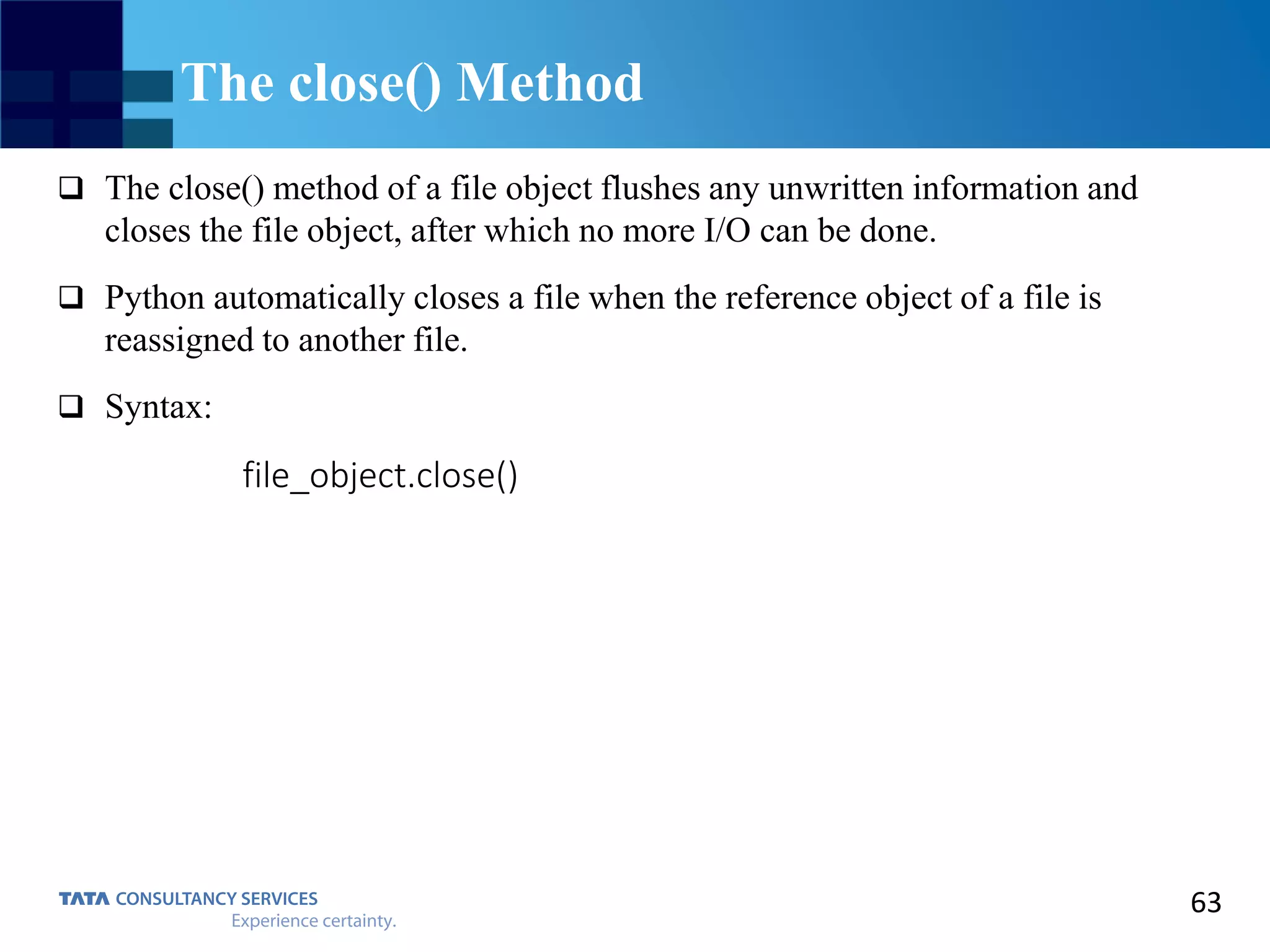
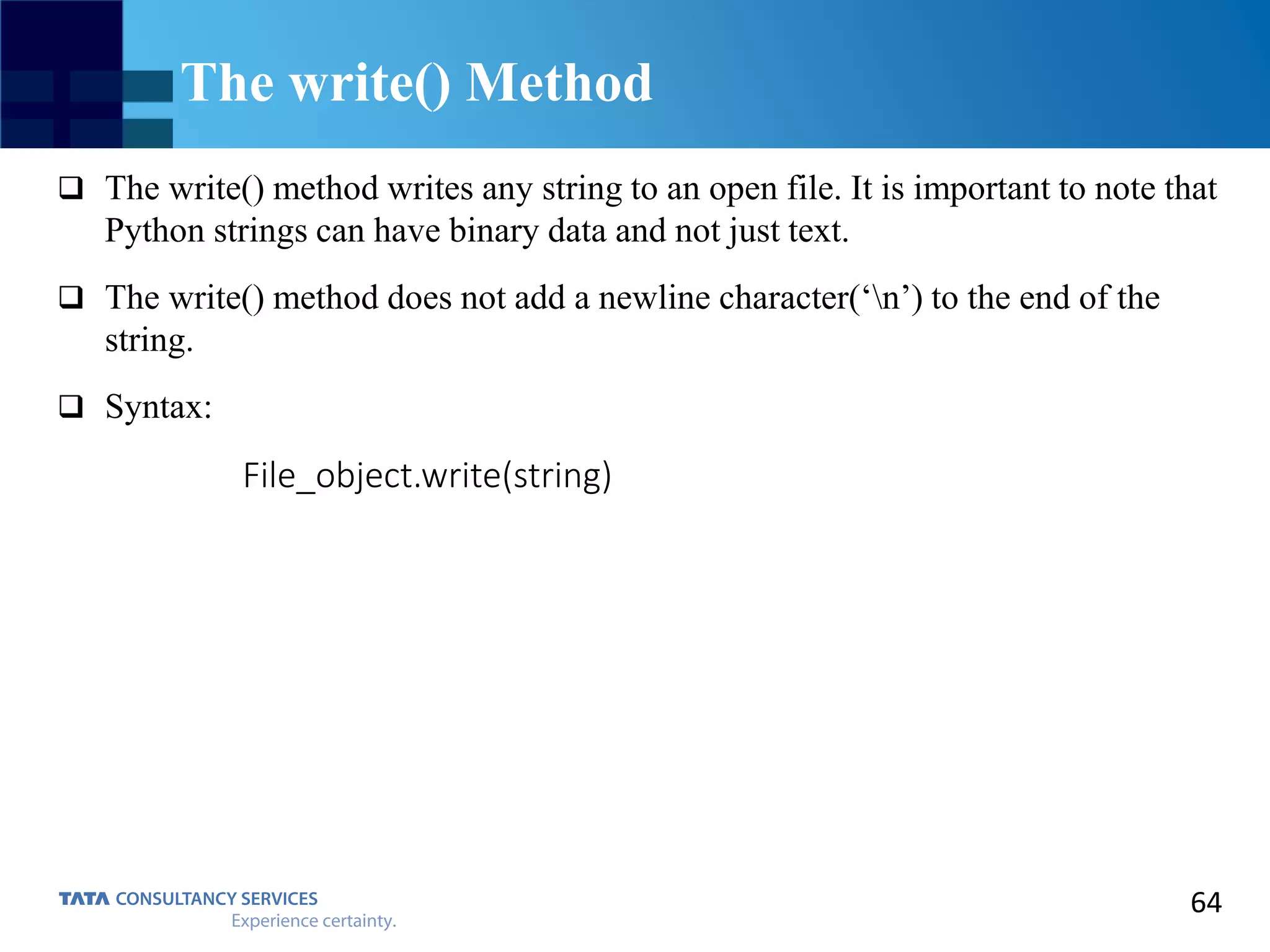
![65 The read() Method The read() method reads a string from an open file. Syntax: file_object.read ( [count] ) Here, the passed parameter is the number of bytes to be read from the opened file. This method starts reading from the beginning of the file and if count is missing, then it tries to read as much as possible, maybe until the end of file.](https://image.slidesharecdn.com/pythoncop-170305112410/75/Intro-to-Python-Programming-Language-65-2048.jpg)
